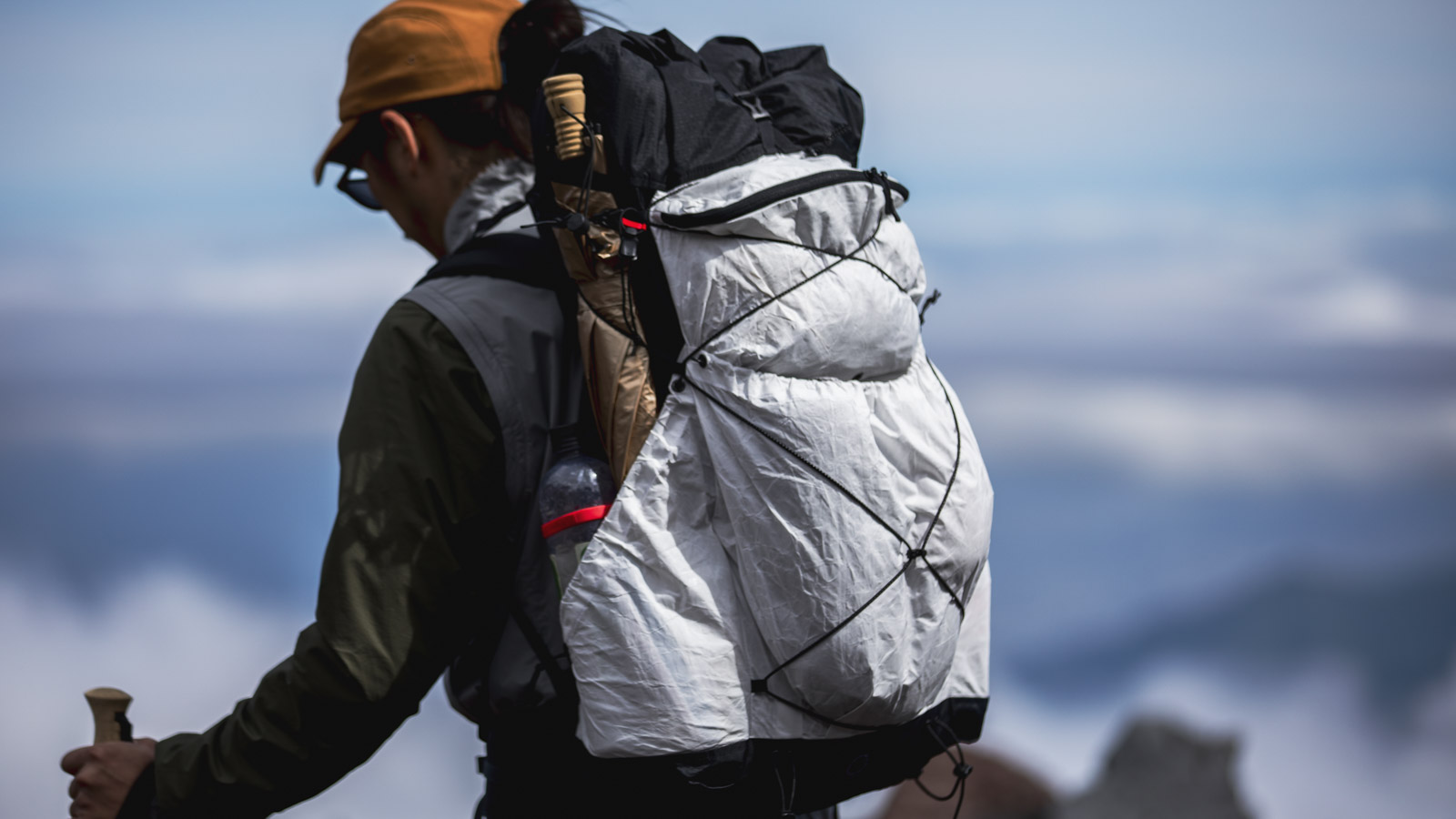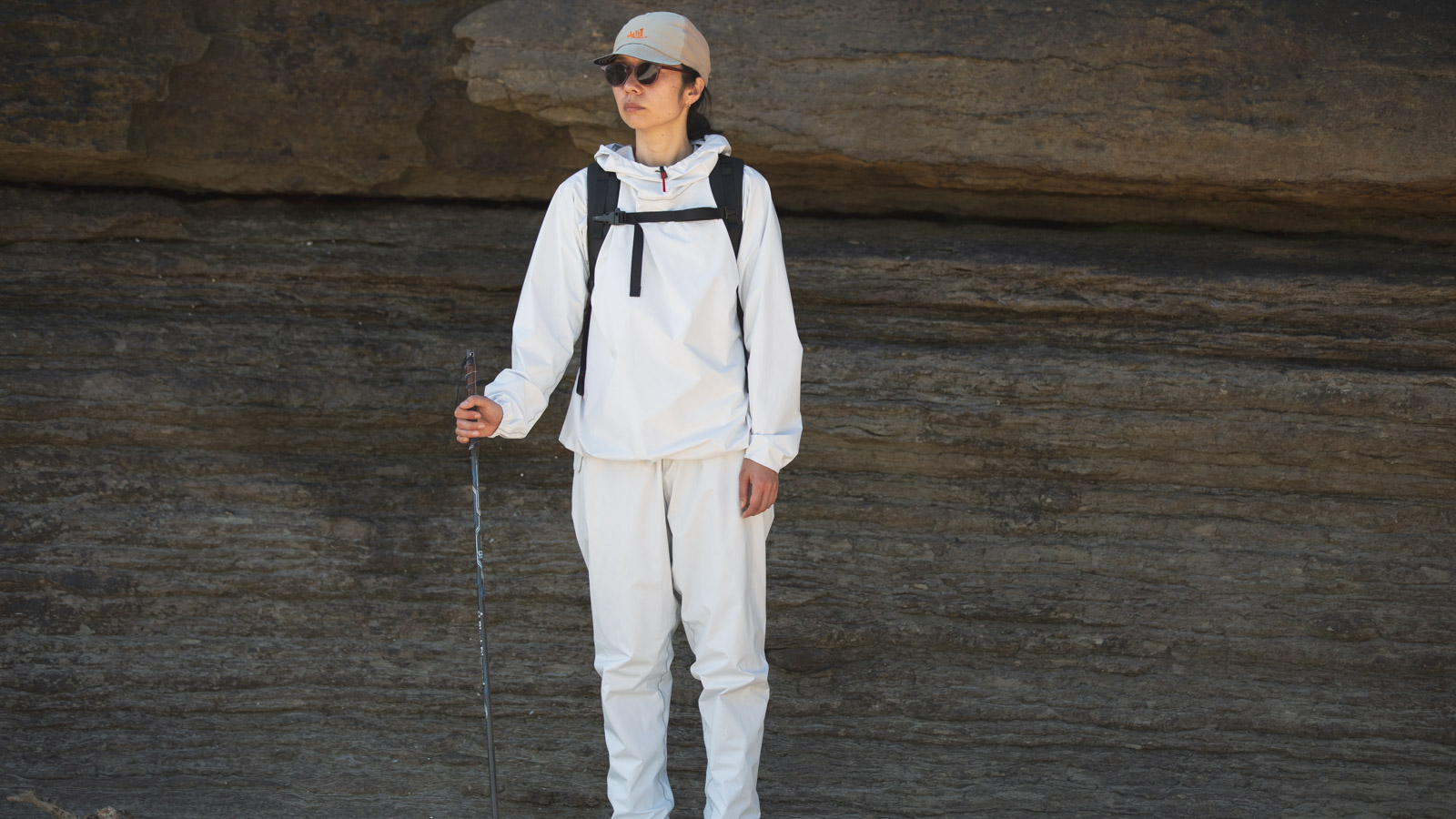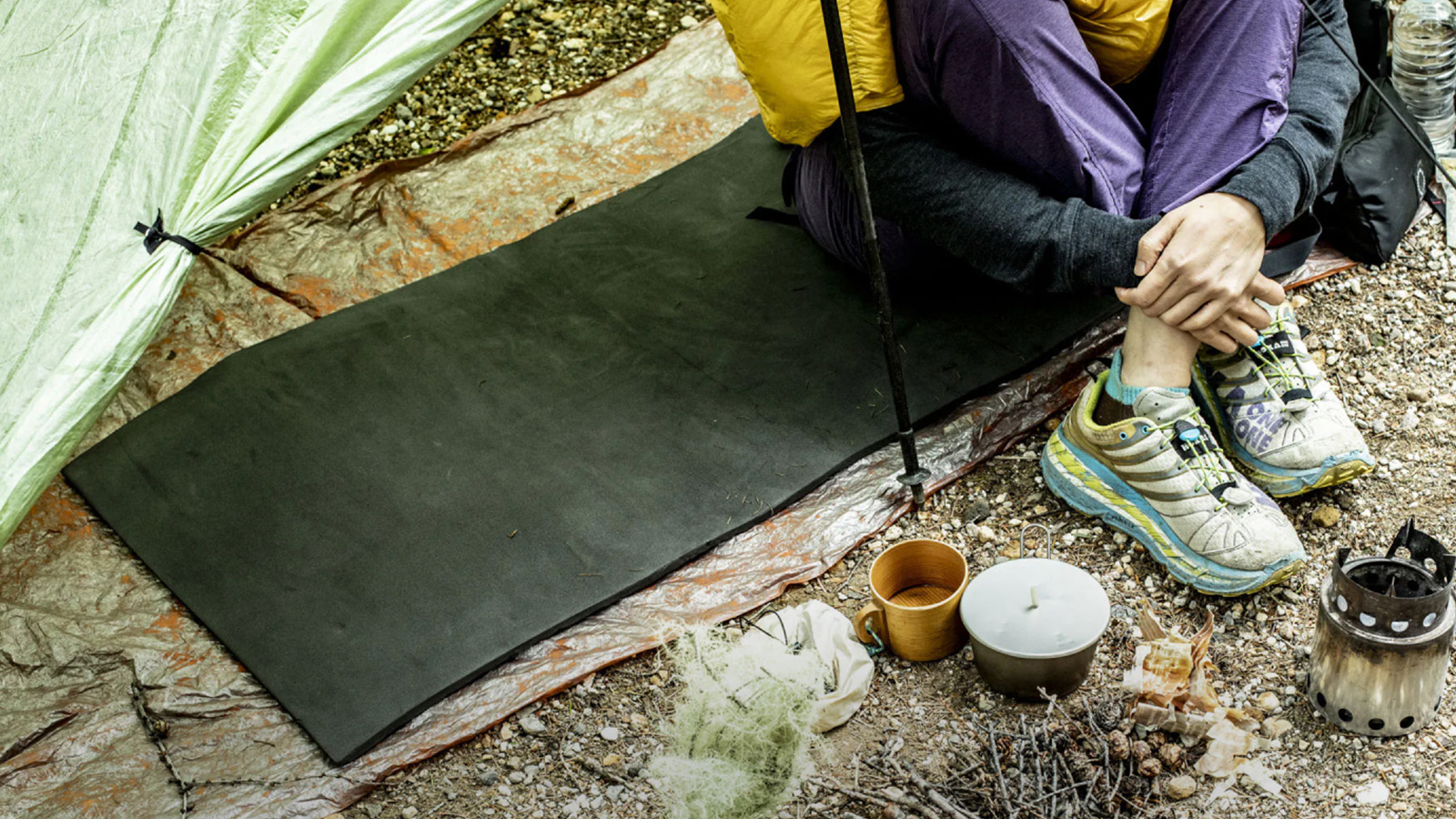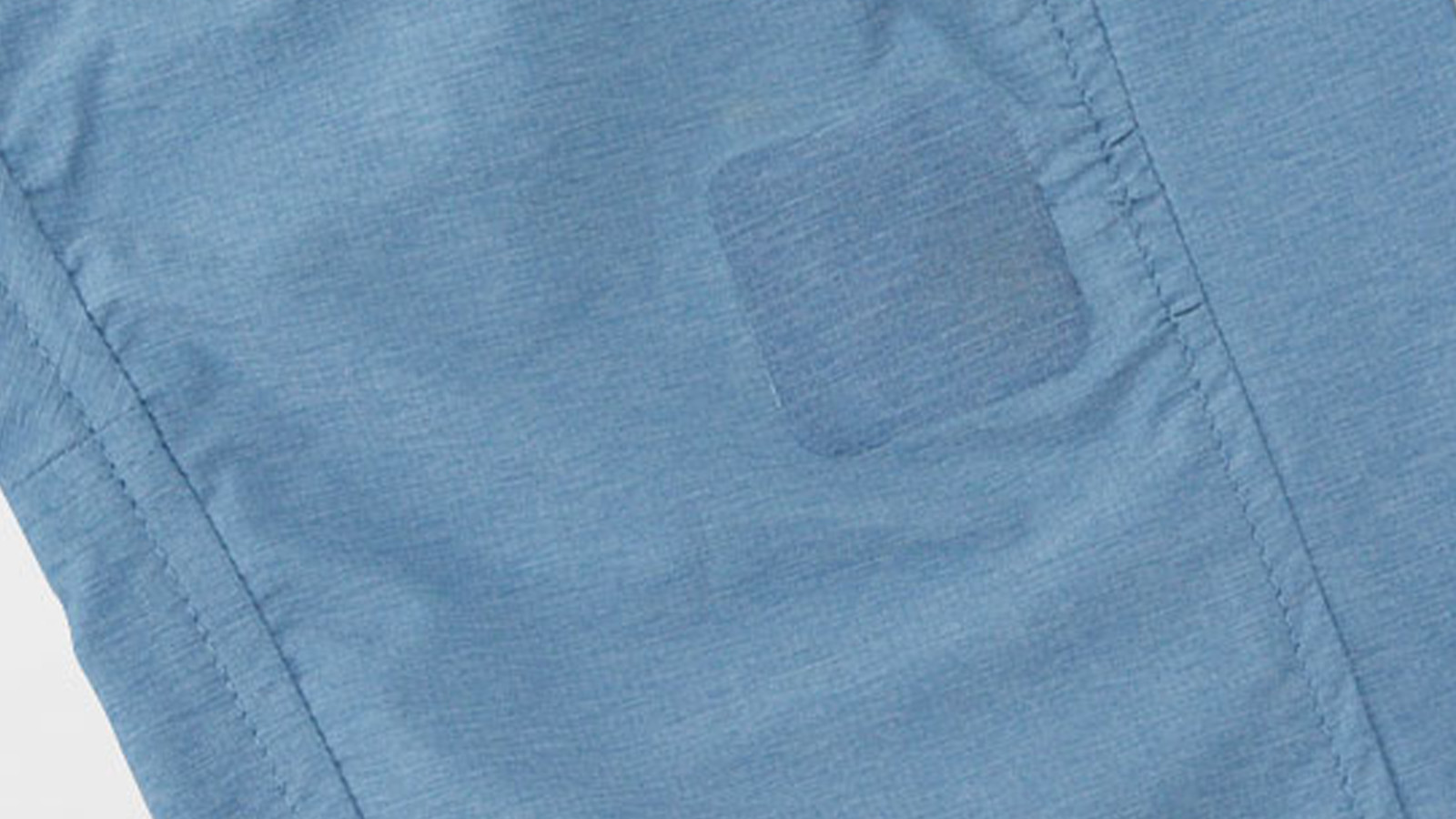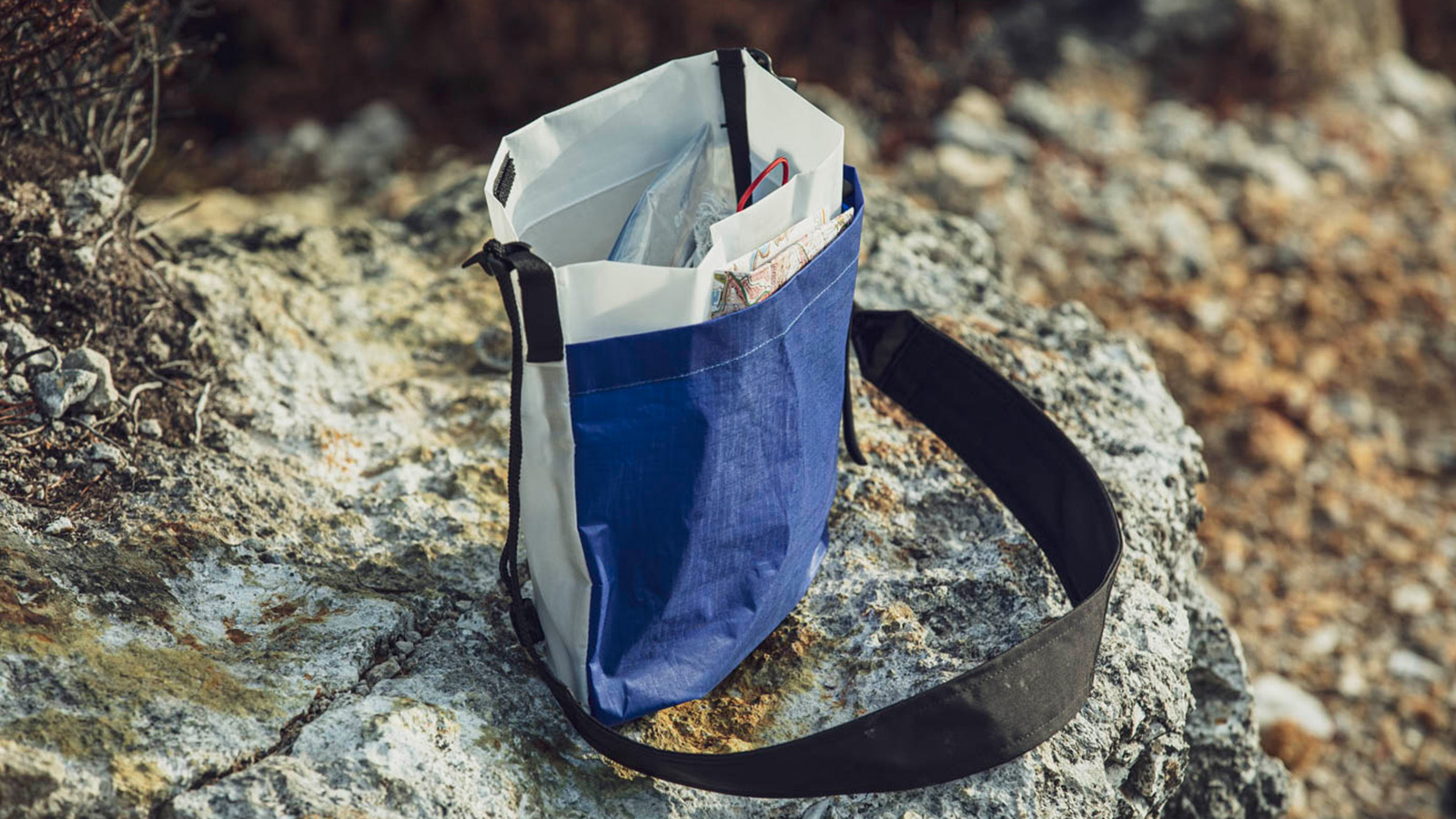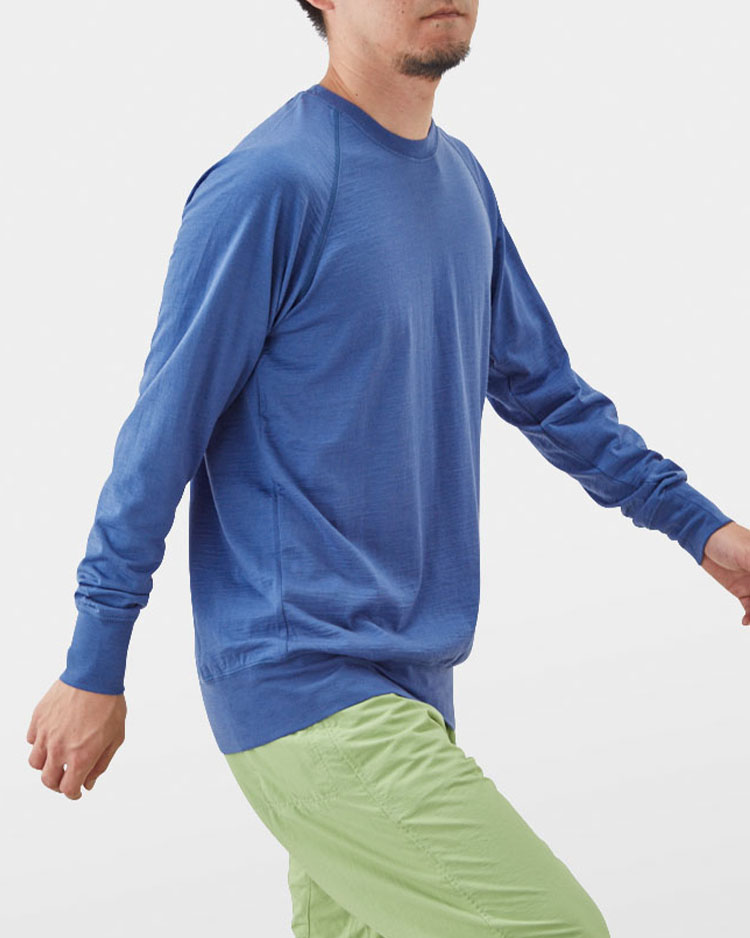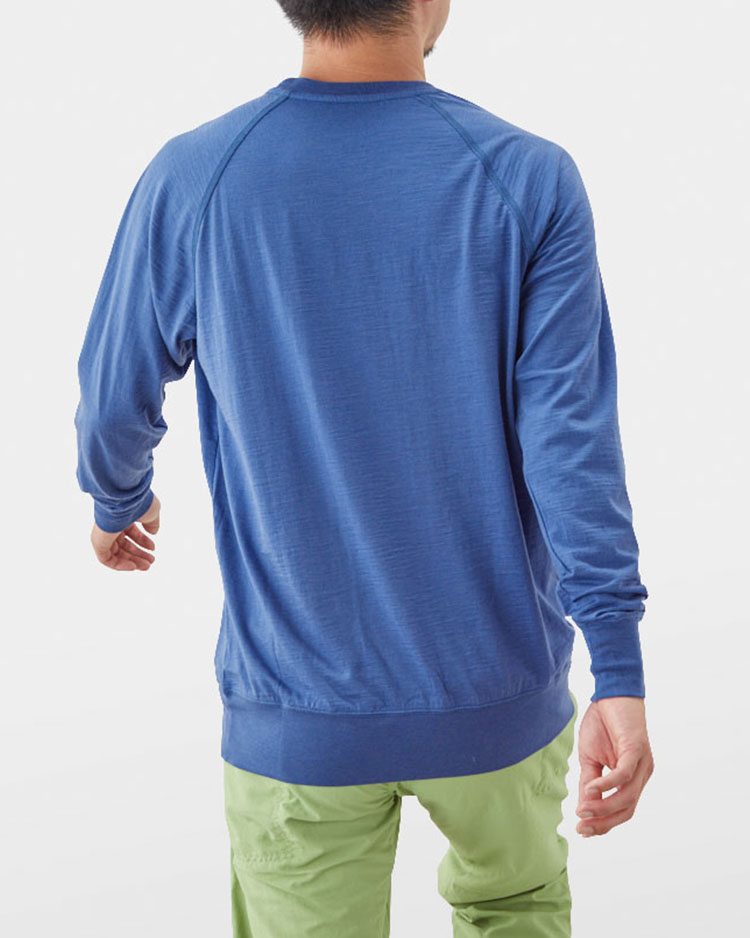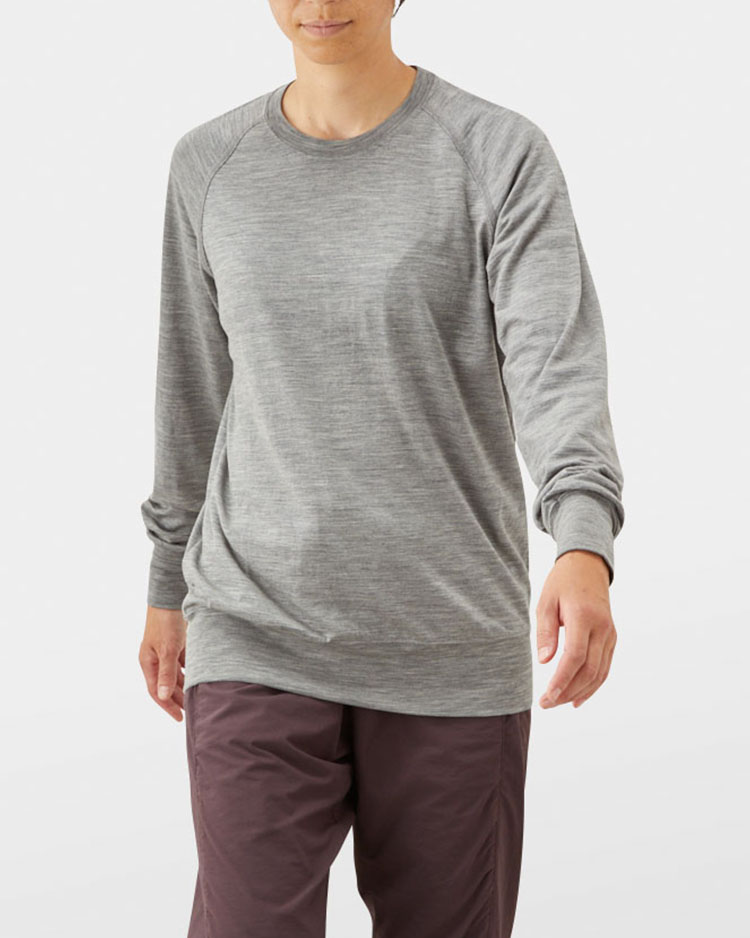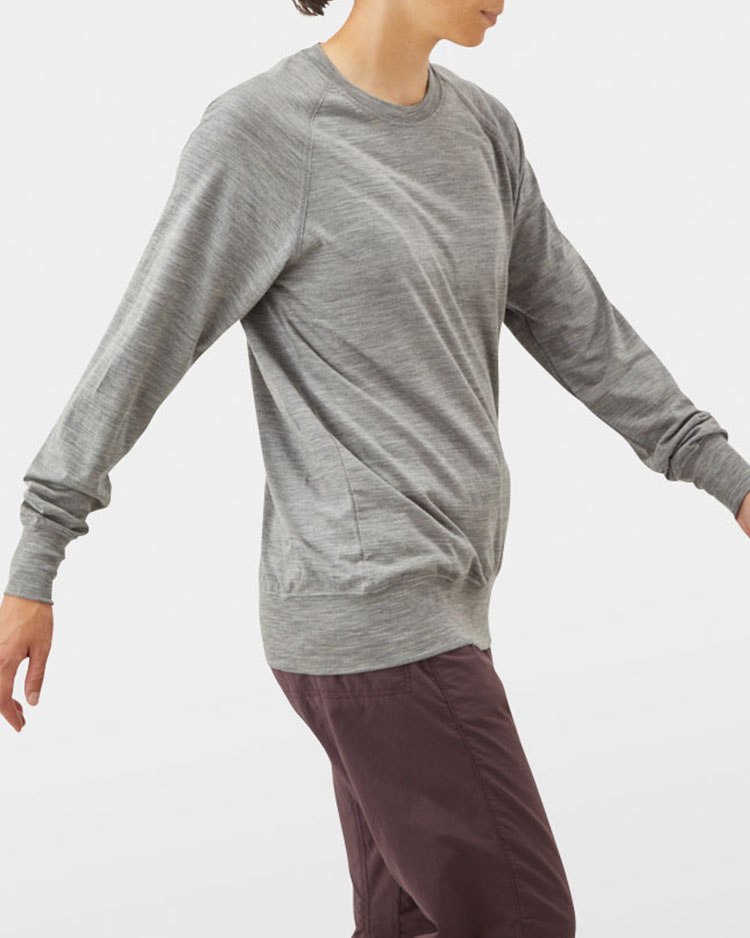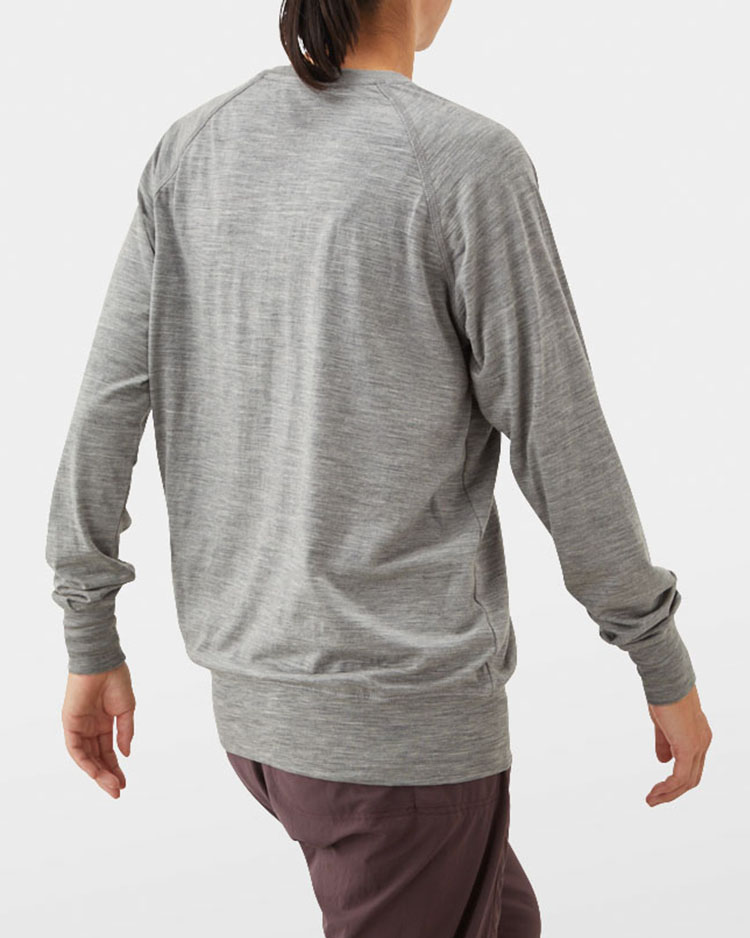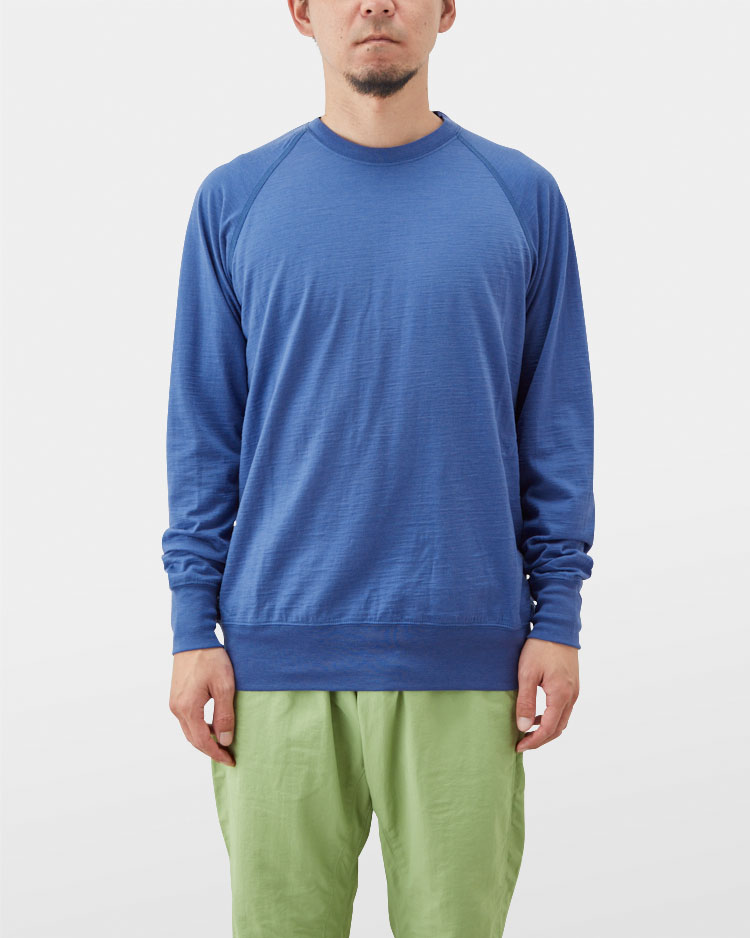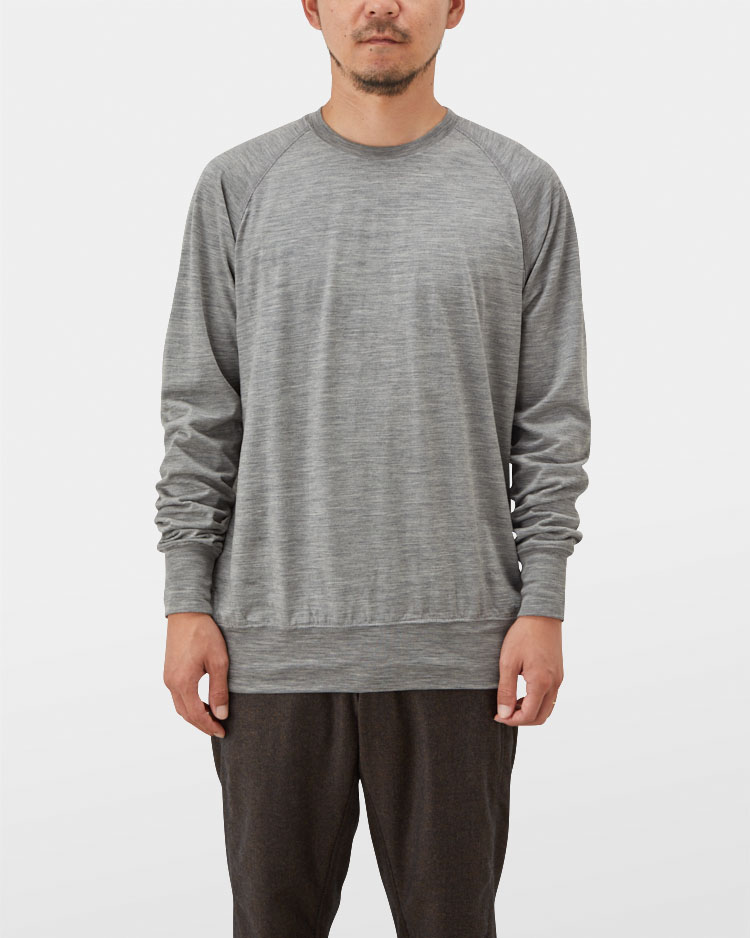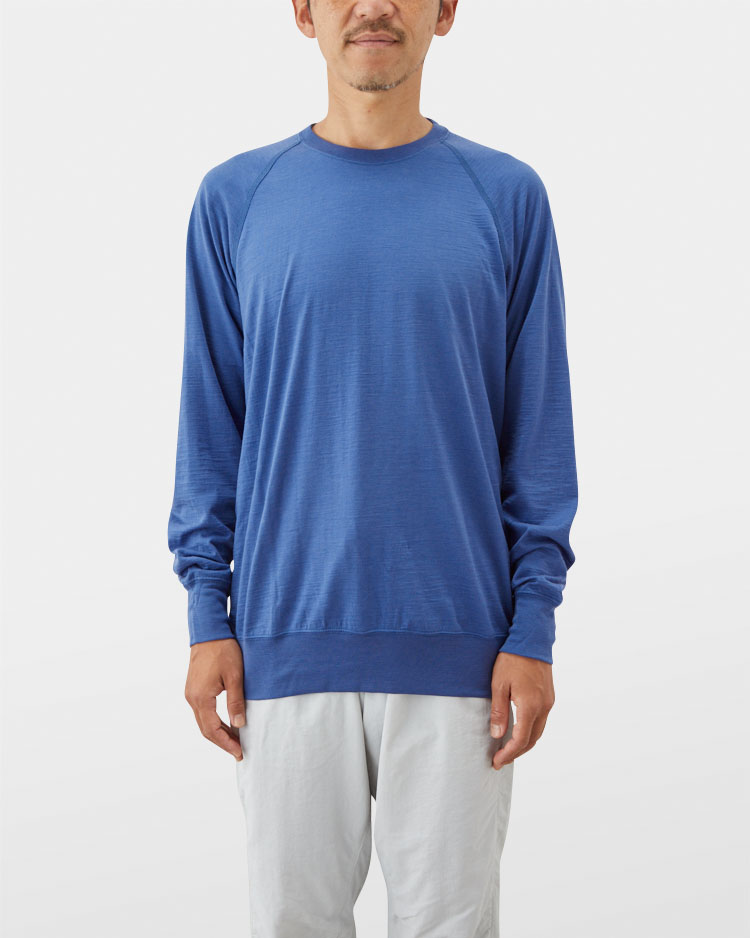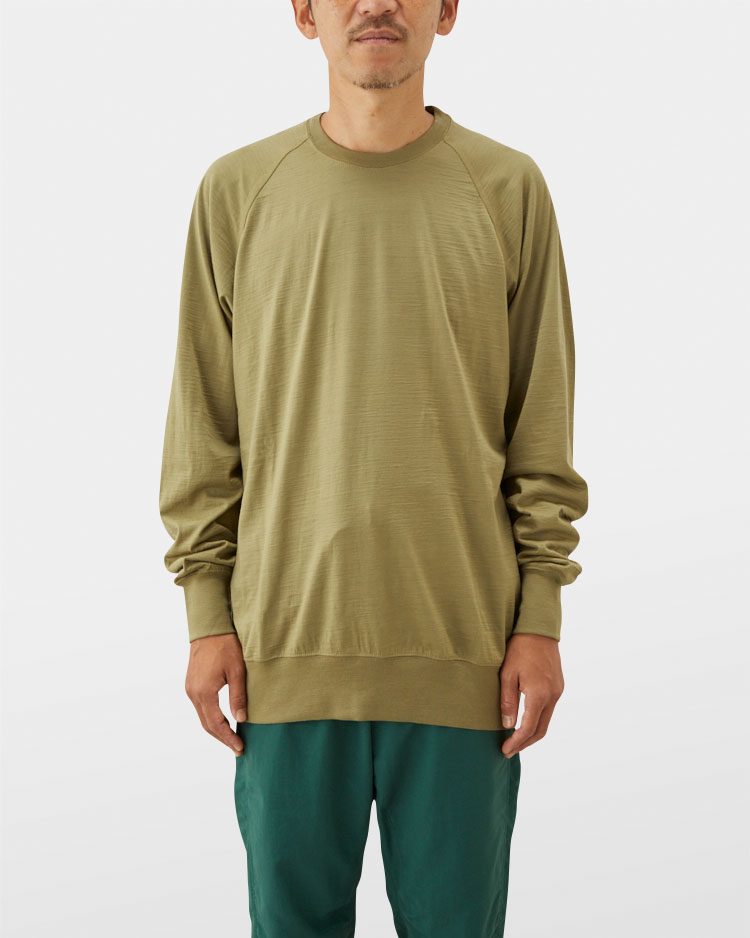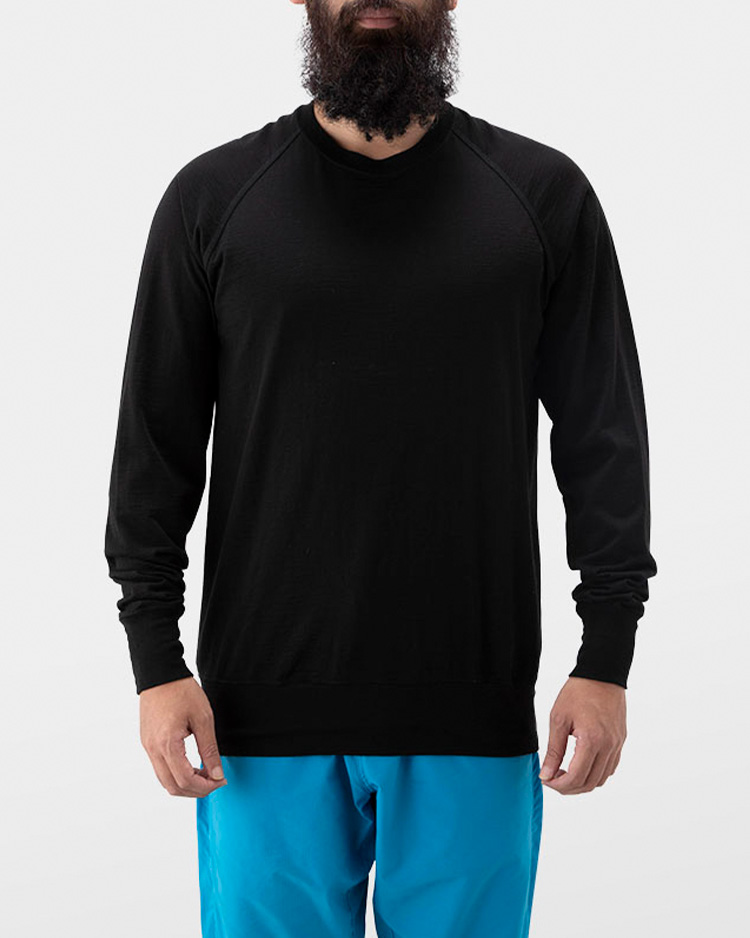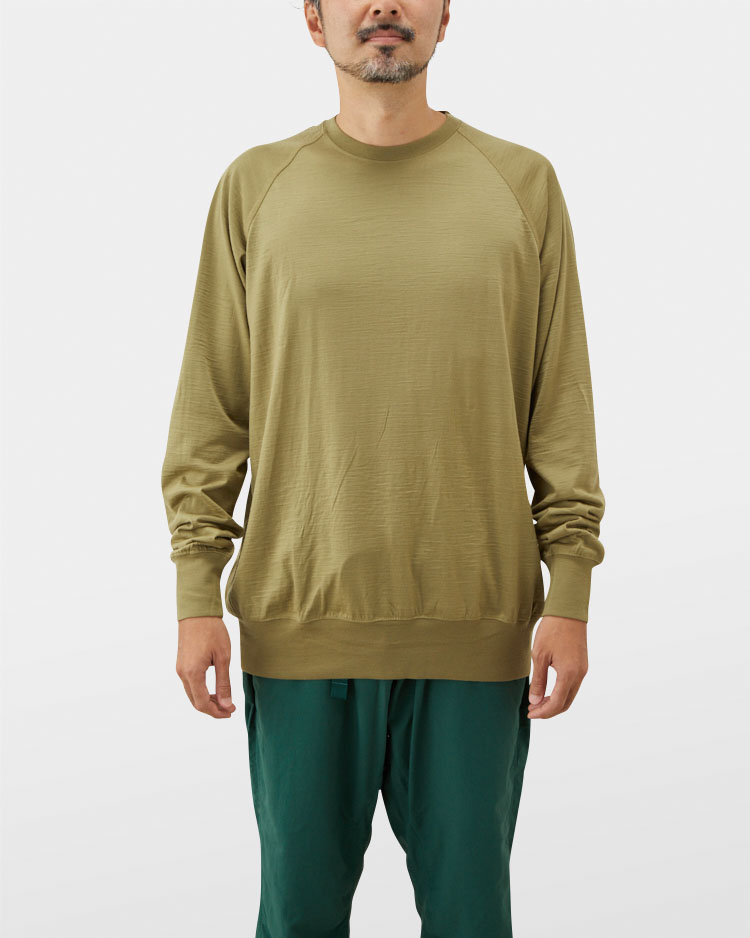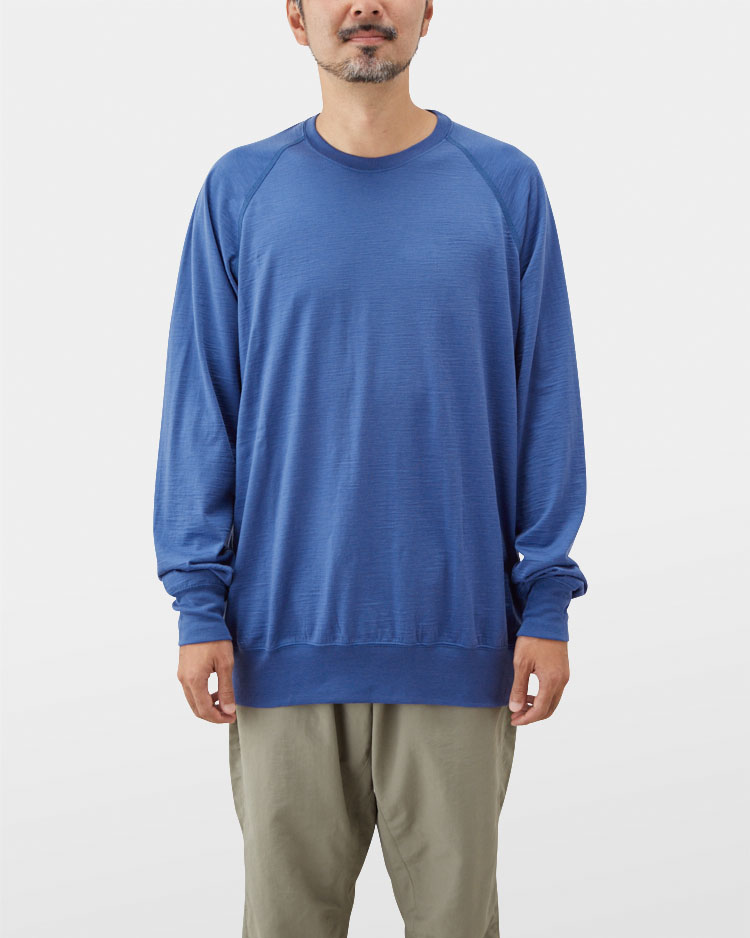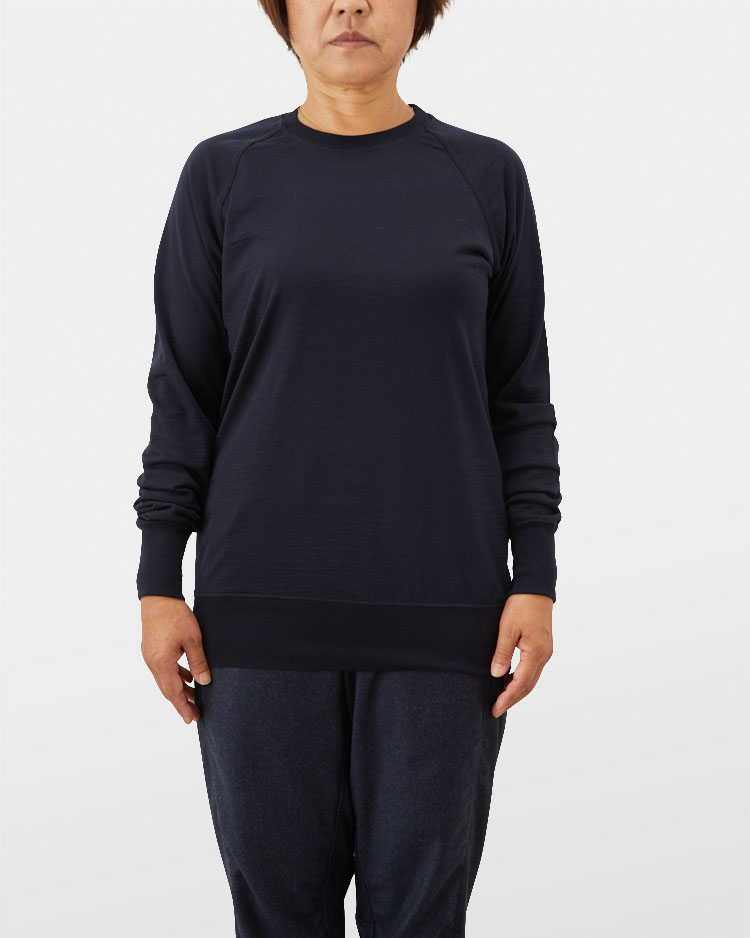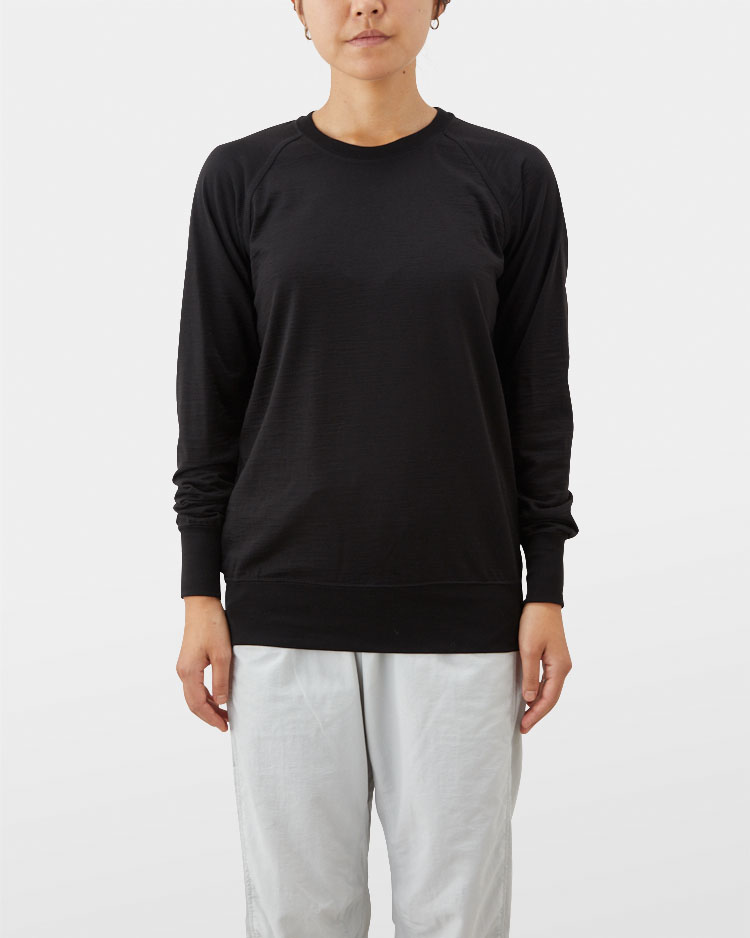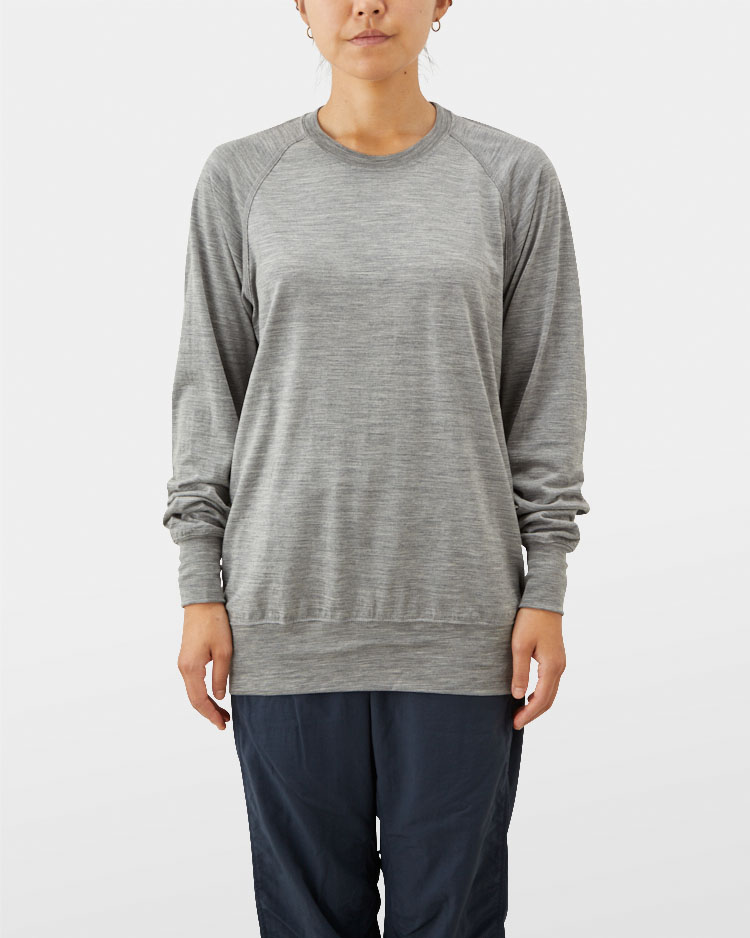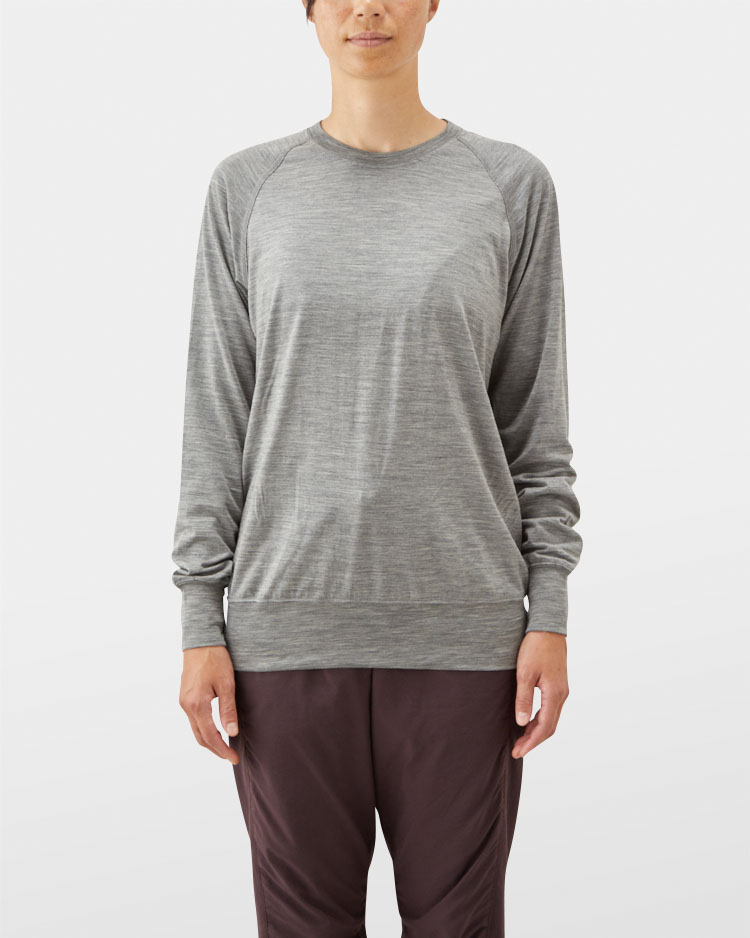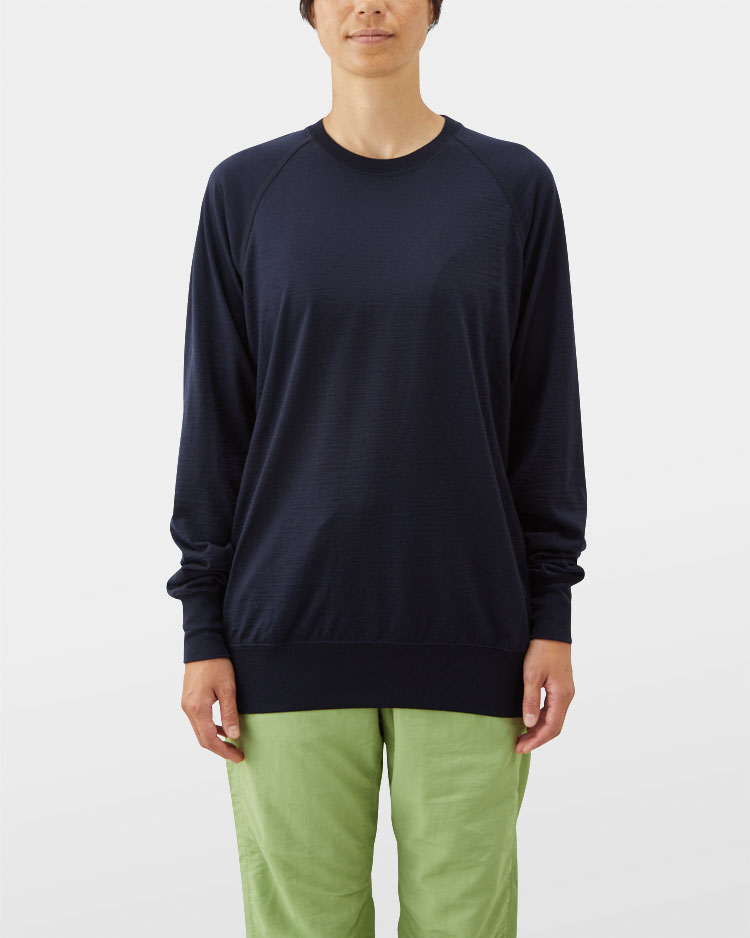252g (Size S)
262g (Size M)
284g (Size L)
305g (Size XL)
- Introduction
- Product Story
- Hood Congestion
- Form and Function
- Where the 100% Merino Stands
- Recommended Scenes
- Naturally Odor Resistant
- Great Moisture Control
- Even Warm When Wet
- Tumble Dryable Pure Merino
- Raglan Sleeves
- Ribbed Cuffs and Hem
- Material
- More Durable and Stable Quality
- Why 100% Merino?
- Disadvantages of Wool
- Size guide
- Instructions
- Hydrophilic 100% Merino
- Tumble-drying
- Care Instructions
Introduction
Perfect Everyday Pullover
The 100% Merino Pullover, made of our proprietary 100% Merino wool fabric (200-205g/m2), works equally well as either a base or mid-layer.
The simple design, like a normal sweater or sweatshirt, blends right in wherever you are, and the ribbed sleeves and hem keep your wrists and belly warm.
Our proprietary pure Merino fabric offers natural heat and humidity regulation as well as deodorization, making it so comfortable you’ll find it hard to ever take it off.
Product Story
Hood Congestion
I love hoods. They guard against the cold wind, and often feel even warmer than a knit cap – I can’t begin to count the number of times I’ve been saved by my hood.
Yamatomichi has many hooded garments, but I realized that during winter if you’re wearing several layers, each with their own hood – whether it be a shell, thermals, base, or mid layers – you end up with a serious case of “hood congestion”.

Tomohiro Kobayashi, wearing the Black color.
You may think, “You can layer hoods, too!” but too many layers around the neck region can be a bit of a problem. Every time that happens, I end up wanting a basic long sleeve base/mid-layer, without the hood.
For this pullover, we developed a new fabric with ribbed cuffs and hems. We’ve always prided ourselves on developing lightweight materials, but maintaining reliable quality can be difficult if focusing too much on weight. Here we opted for a soft, slightly thick ribbed construction just perfect for a pullover.
Form and Function
Where the 100% Merino Stands
Though this product dries slower than general synthetic base layer T-shirts, it is less likely to cause hypothermia caused by the evaporation of sweat or other moisture. In other words, the new 100% Merino series focuses on moisture absorption rather than quick-drying, and on thermal insulation rather than cooling properties.a

Recommended Scenes

When the temperature changes drastically
Wool is good at maintaining a constant temperature inside the garment, keeping you dry and comfortable even in situations where temperatures can suddenly change.
When worn under an outer shell
Synthetic base layers with low moisture absorption can feel very humid and stuffy. On the other hand, our 100% Merino’s superior moisture absorption properties, will help to keep you dry and comfortable when worn under an outer shell.
When worn for long hours
Synthetic clothes often become smelly relatively early on, even if they are deodorant finished. Wools, on the other hand, naturally eliminate odor when the fabric dries even after being soaked in sweat. This powerful anti-odor performance allows you to keep moving day after day, relatively comfortably without smelling too bad.
When packing capacity is limited
Our Merino wool products can be worn in various situations for long hours without getting too smelly, minimizing the need for extra clothes in your backpack.
Naturally Odor Resistant
Wool base layers are chosen by many hikers for the material’s excellent odor neutralizing performance. Some say it’s almost odor-free even after a week of heavy hiking, but we’ll let you (and your friends) be the judge of that…
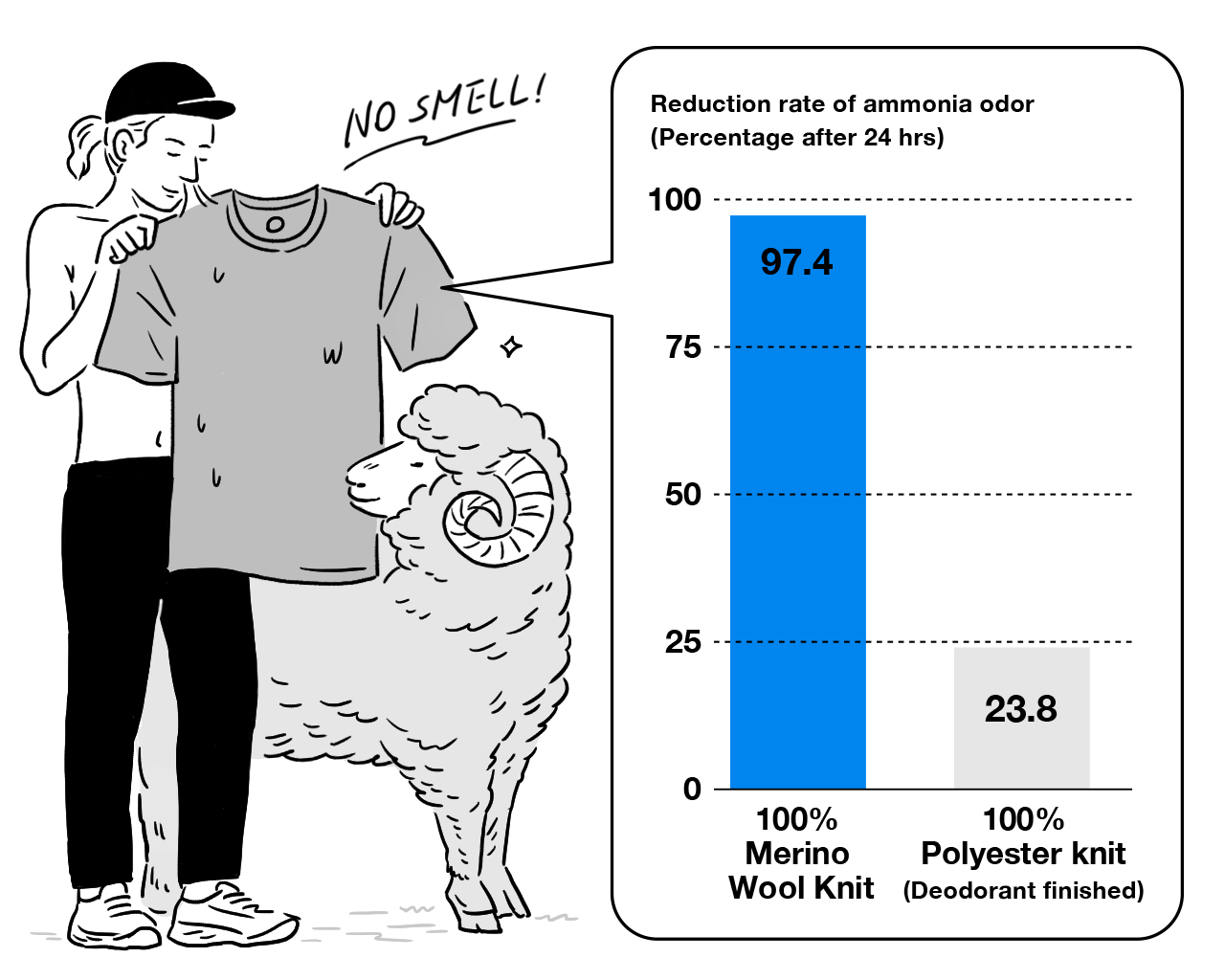
Wool’s deodorant mechanism is still a mystery. One theory has it that wool absorbs a large amount of odor-causing elements, and consequently, the odor is minimized to the level that cannot be detected by the sense of smell. We will conduct our own experiments and tests in the future.
Great Moisture Control
Wool is great to help you keep warm and cool as it naturally controls the moisture level within the clothes, always keeping you comfortable throughout the year.
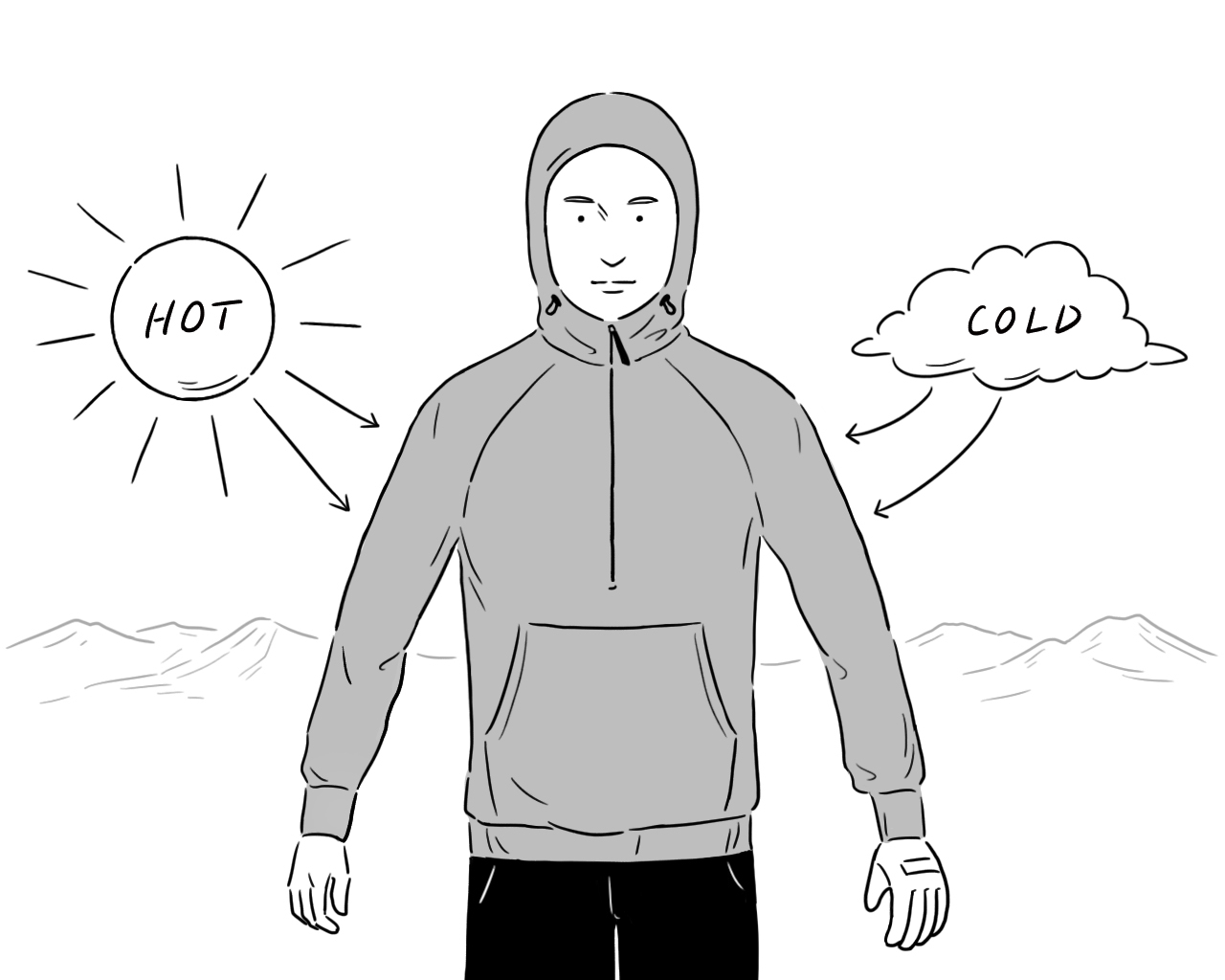
Wool’s peculiar function is the benefit of the dead-air space between the crimped wool fibers, allowing for the excellent breathability and moisture permeability. Furthermore, the cortex’s water absorption performance variably changes according to the humidity level of the outer air, that is, the higher the humidity outside, the more moisture it absorbs.
The air layer inside the fiber made by the “crimp” works as a loft to retain heat in the same way as down and synthetic fibers, and it performs better thermal insulation than cotton and synthetic fibers of the same weight.
Even Warm When Wet
First, when wool absorbs moisture, the thermal phenomenon called “absorption heat” is generated. Secondly, its excellent insulation properties (low thermal conductivity) prevents the body heat from being lowered by evaporation. Also, the crimped fibers are bouncy and retain loft without crushing even when wet. In addition, wool can absorb more moisture in between the fibers, always keeping the skin dry and comfortable.
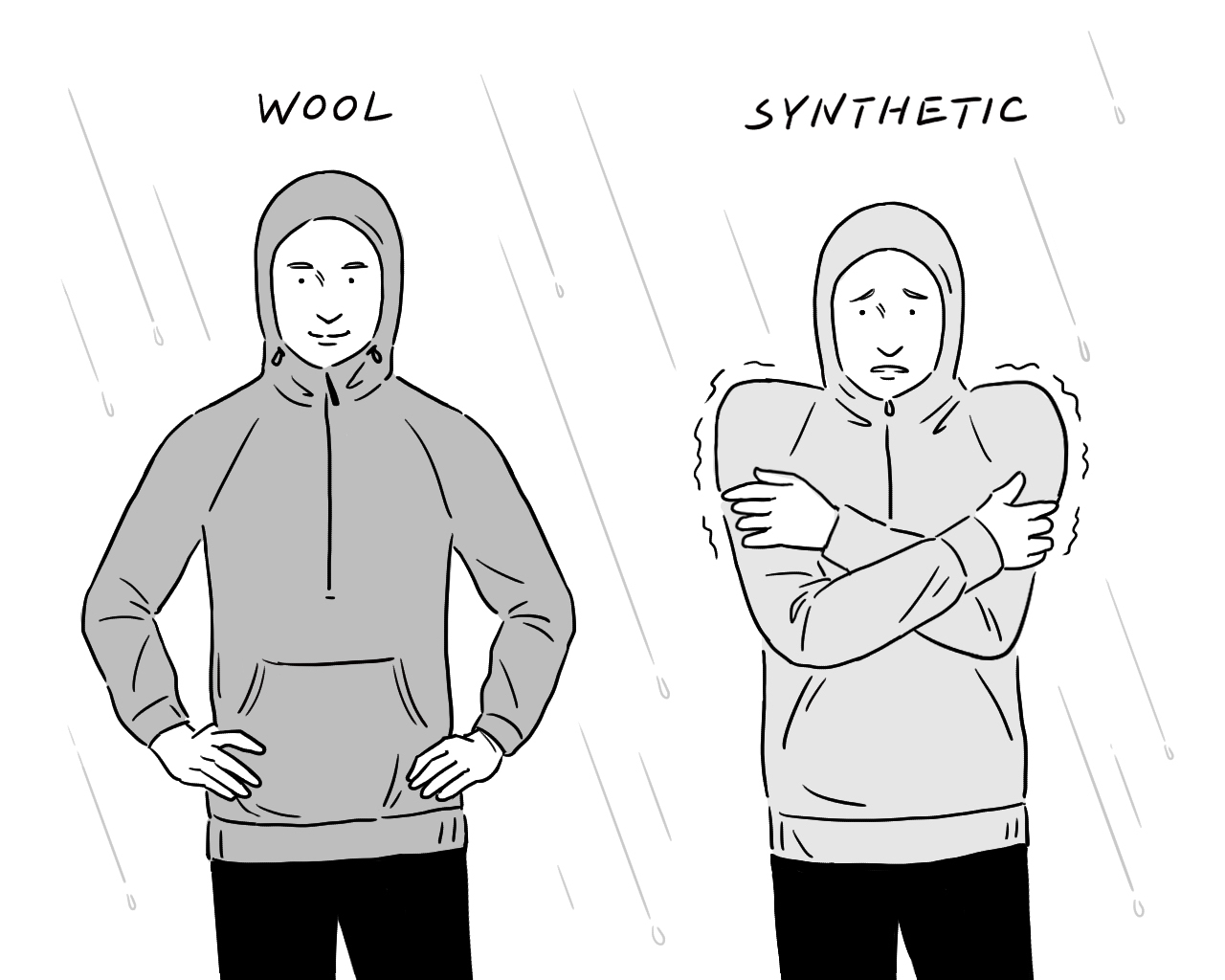
When fibers absorb moisture, the thermal phenomenon called “absorption heat” is generated. The wool’s adsorption heat performance is twenty times of polyester, and 2.5 times of cotton.
Tumble Dryable Pure Merino
Normally, Merino wool products cannot be tumble dried as the heat causes shrinkage and deformation of the fabric, but our proprietary 100% Merino wool can be tumble dried* at low temperatures (Upper limit of 60 Celsius).
This makes it better suited for long hikes and travels, as you can easily use dryers at laundromats and hotels.
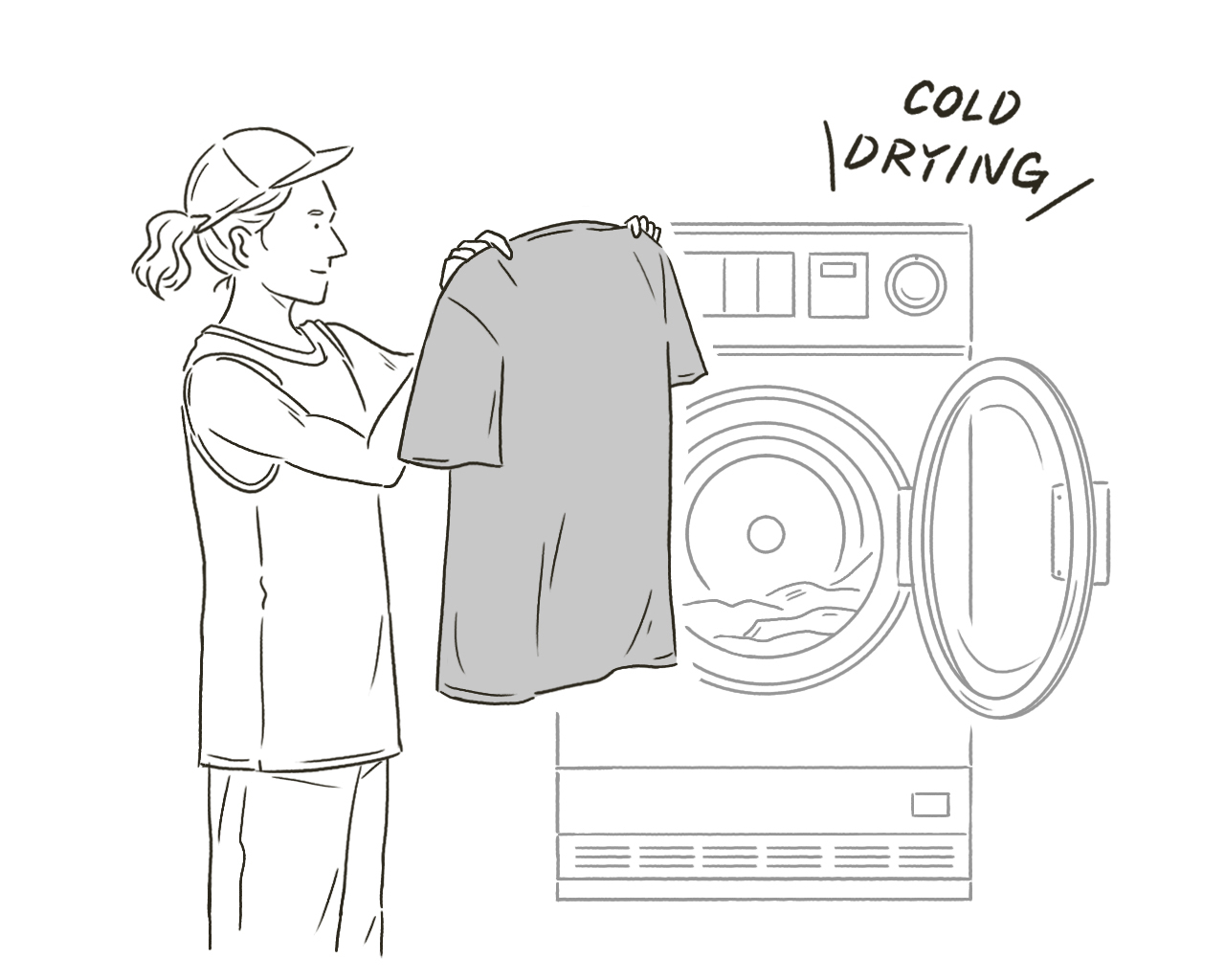
*Some shrinkage may be caused by tumble drying, but the shirt will return to its original shape as you wear it. Repeated use of the dryer may deteriorate the fabric, so we recommend using it only when necessary.
Raglan Sleeves
The raglan sleeves enable easy movement of the shoulders and arms. The neckline is neatly trimmed by a neckband.
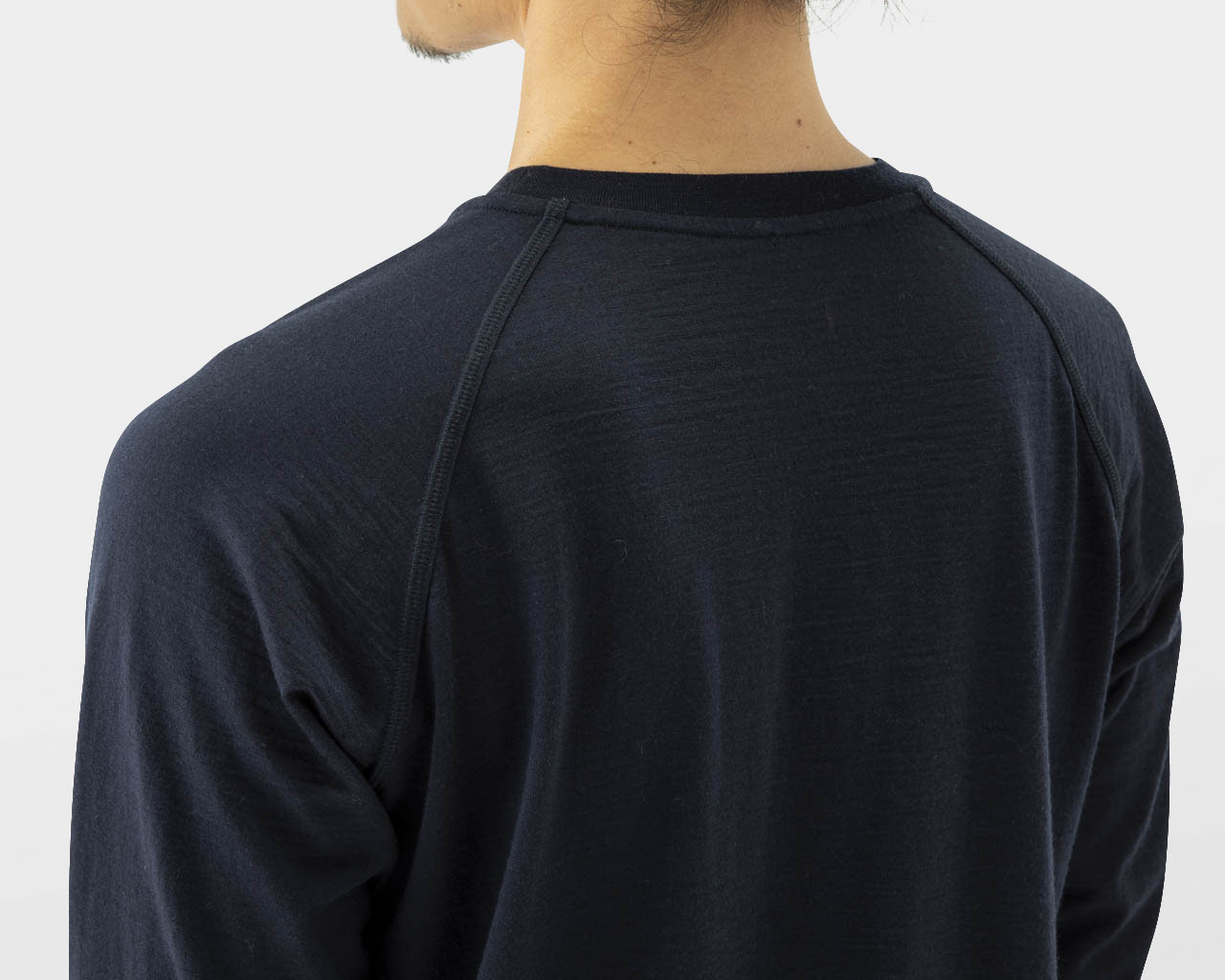
Ribbed Cuffs and Hem
The ribbed cuffs work as simple wrist warmers, helping to prevent heat loss and keep out the cold. By rolling up your sleeves you can quickly and effectively cool down. The thick ribbing helps retain warmth, which is important, as the abdomen, lower back, and buttocks are susceptible to the cold.
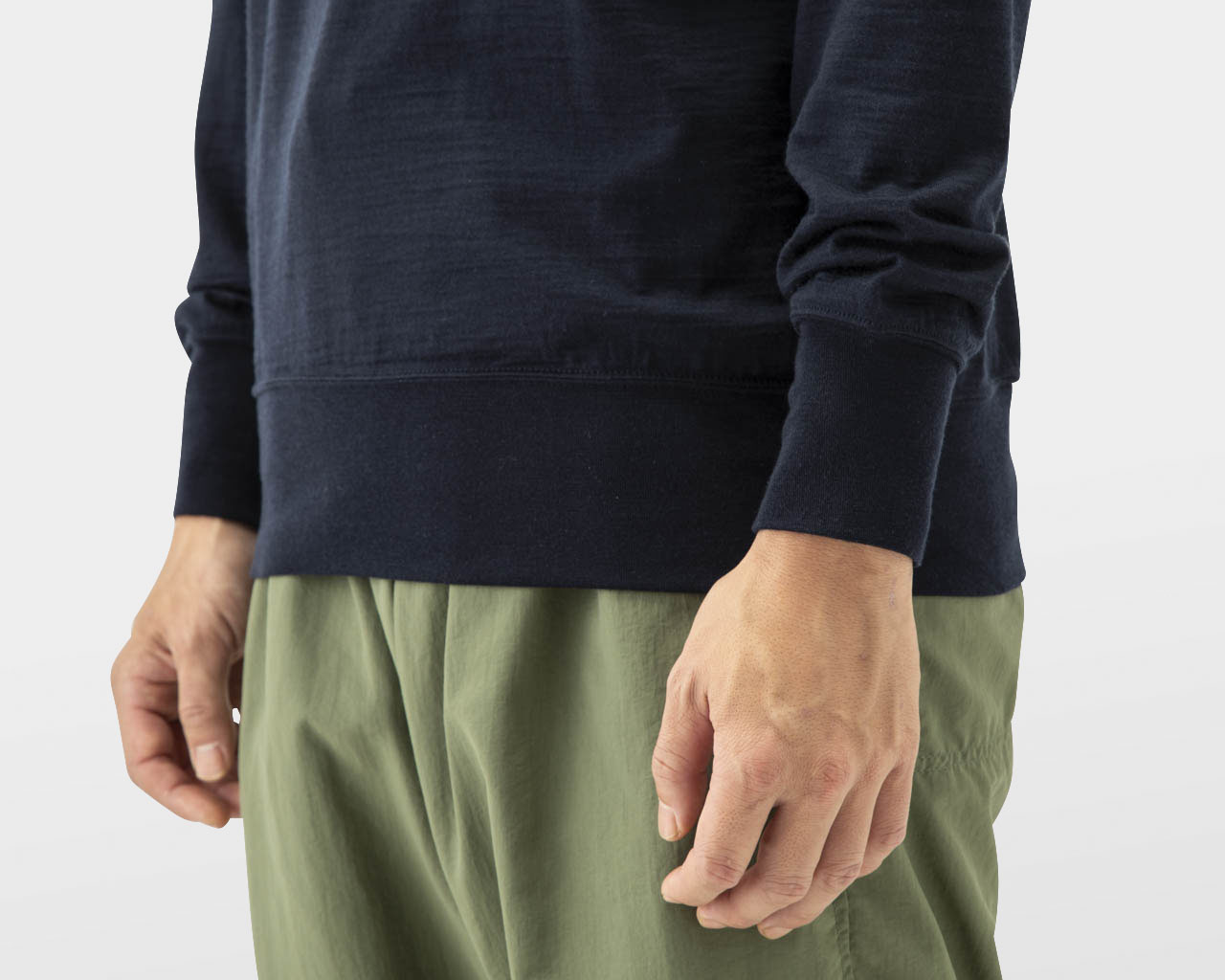
Material
More Durable and Stable Quality
Our previous Merino series was produced by a combination of two strands of wool twisted together, known as “ply yarn”, featuring light and soft texture. However, this method could cause shrinkage after washing, possibly resulting in the partial bursting of the fabric.
So we analyzed the New Zealand Merino wool that we used in our old products to examine the optimal spinning and knitting methods; Our conclusion was to work with single yarn.
The fabric is pre-shrunk through tumble drying, which is a rare process for Merino clothes, making the fabric tight and compressed but bouncy. The process makes the fabric softer and more stable, allowing it to be tumble-dried at a low temperature.
Our proprietary fabric is produced in Bishu, the production area of wool garments in Japan, in cooperation with the spinning company, fabric factory, dyeing, and processing factory, and inspection organization. We continue our effort to innovate with new products and markets.
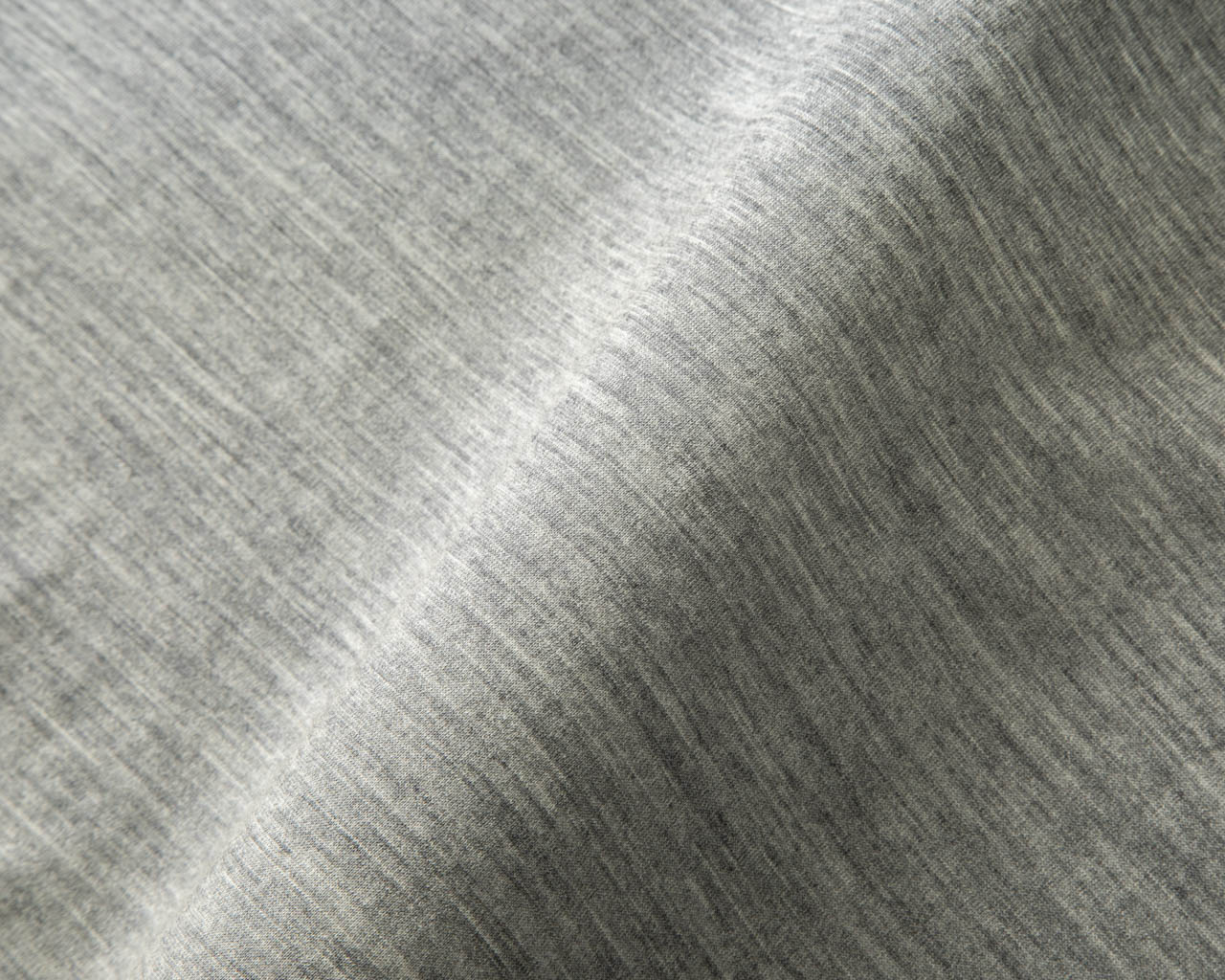
100% Merino Wool
Weight: 200-205g/m²
Yard count: 1/38
Bursting strength (JIS L1096A): 400kPa
*The value of the pressure when the rubber membrane tears the fabric as the membrane is continuously pressurized.
Heat retention (JIS L1096A): 24%
*Energy loss when the fabric is placed on the heat source.
Why 100% Merino?
Wool is a natural material with various unique features such as temperature/moisture control, thermal insulation, and is naturally odor-resistant. All developed by sheep to survive the harsh environment over time.
Merino wool comes from merino sheep and compared to other kinds of wool, merino’s fiber is finer, softer, and less scratchy, and hence even suitable for making underwear and baselayers.
All wool, including merino wool, is cool in summer and warm in winter. It is warm even when it’s wet, and practically odor-free even after many hours of wear.
While many other manufacturers add synthetic fibers to strengthen their Merino fabrics, we wanted to stick with 100% Merino to maximize the natural benefits of pure merino wool. Our merino will keep you dry even when it’s hot and humid and comfortable no matter the climate.
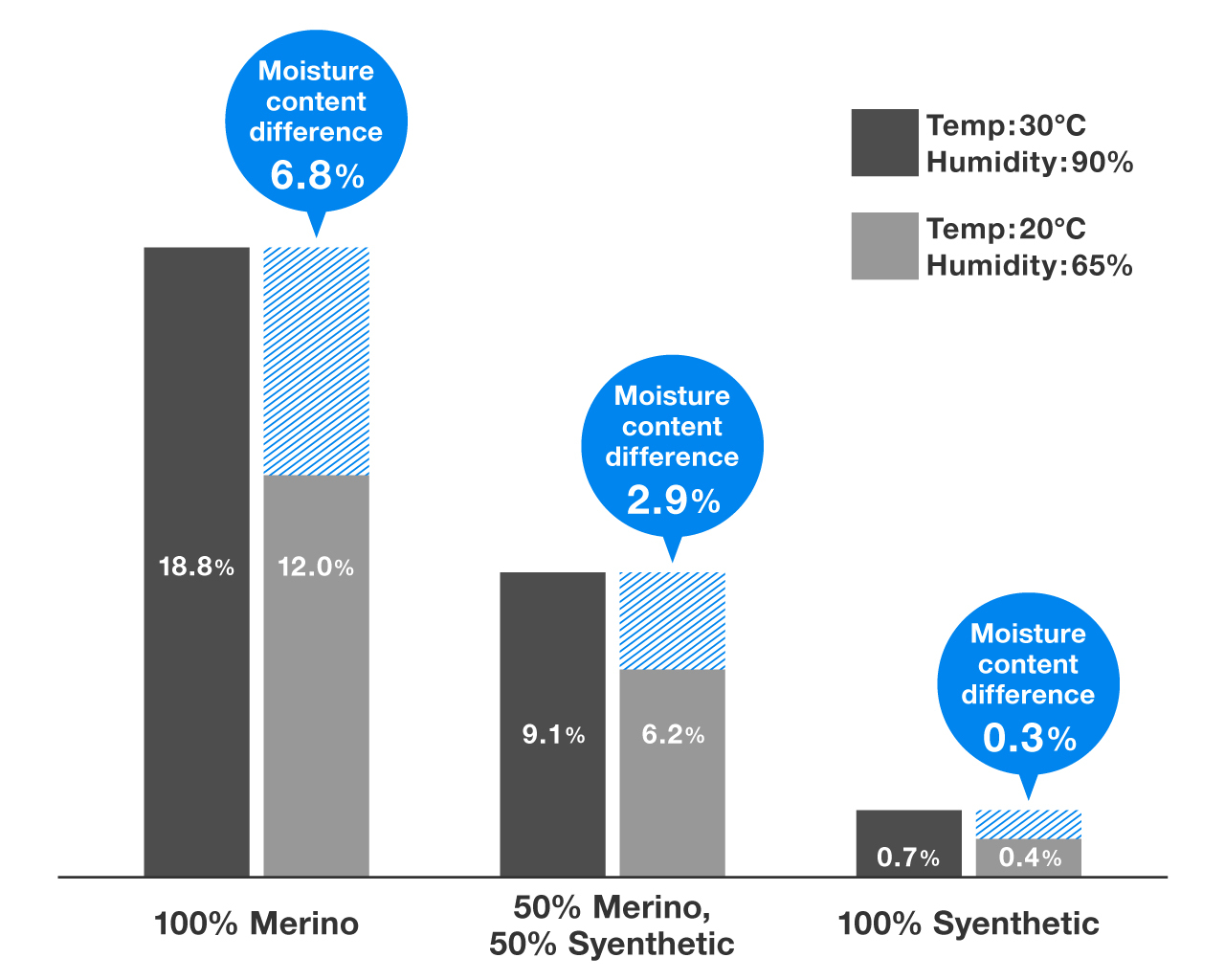
The above chart shows the comparison of moisture content ratio of three types of fabrics in a humid and hot environment (up, 30˚C with 90% humidity) and a more comfortable environment (down, 20˚C with 65% humidity).
In a humid and hot environment, the fiber with superior moisture absorption keeps you dry and comfortable. On the other hand, in dry conditions, it is more comfortable when the fiber provides a certain level of moisture without excessively absorbing available humidity. The difference of the moisture content ratio in the above chart indicates the moisture control performance: the greater the value is, the better the fabric’s moisture control performance is, therefore the larger percentage means better comfort.
The 100% merino fabric, as shown above, has a 6.8% moisture ratio difference. This means that our merino material can effectively control the moisture compared to the other fabrics, keeping you dry when it’s hot and humid while supplying a moderate amount of moisture when the humidity is low. This is the reason why the merino wool is known as “a natural air conditioner”.
Merino Wool
Wool is a natural material with various unique features such as temperature/moisture control, thermal insulation, and anti-odor performance; all of them developed by sheep to survive the harsh environment over time.
Merino wool comes from merino sheep and compared to other kinds of wool, merino’s fiber is finer, softer, and less scratchy, and hence even suitable for making underwear.
All wools, including merino wool, are cool in summer and warm in winter. It is warm even when it’s wet, and practically odor-free even after many hours of wear.
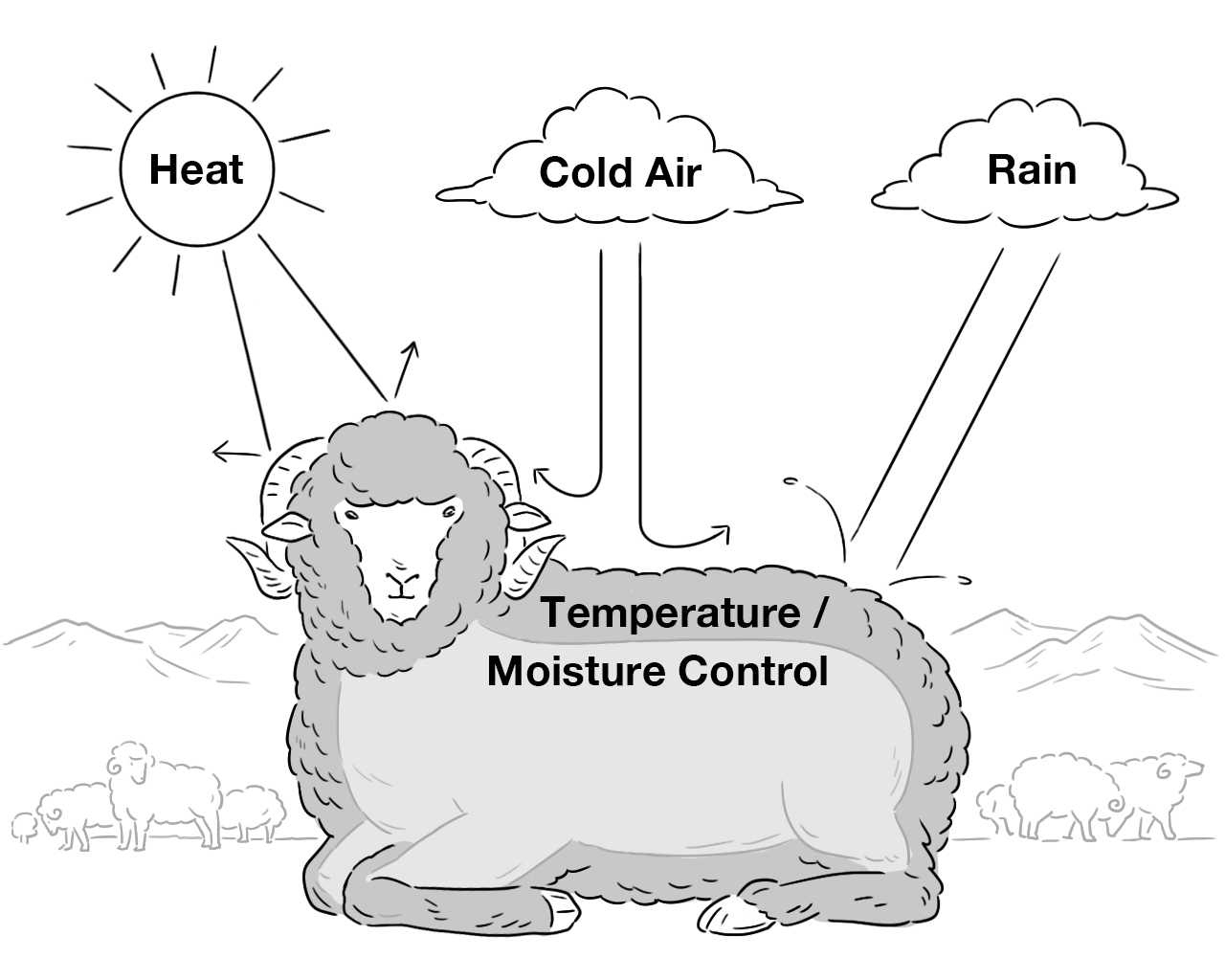
Wool’s Structure
The wool’s fiber is composed of amino acid-based protein, just like human hair and skin. The surface is called the “scale”, which is similar to a fish scale, and the inner part is the “cortex”.
The cortex is composed of ortho-cortex and para-cortex, each with different moisture absorption performance. Because each of them differs in property, the combination of ortho and para cortexes makes the fiber “crimped”.
This crimped structure produces the wool’s unique features such as moisture/temperature control property and thermal insulation performance, avoiding the coldness caused by the sweat.
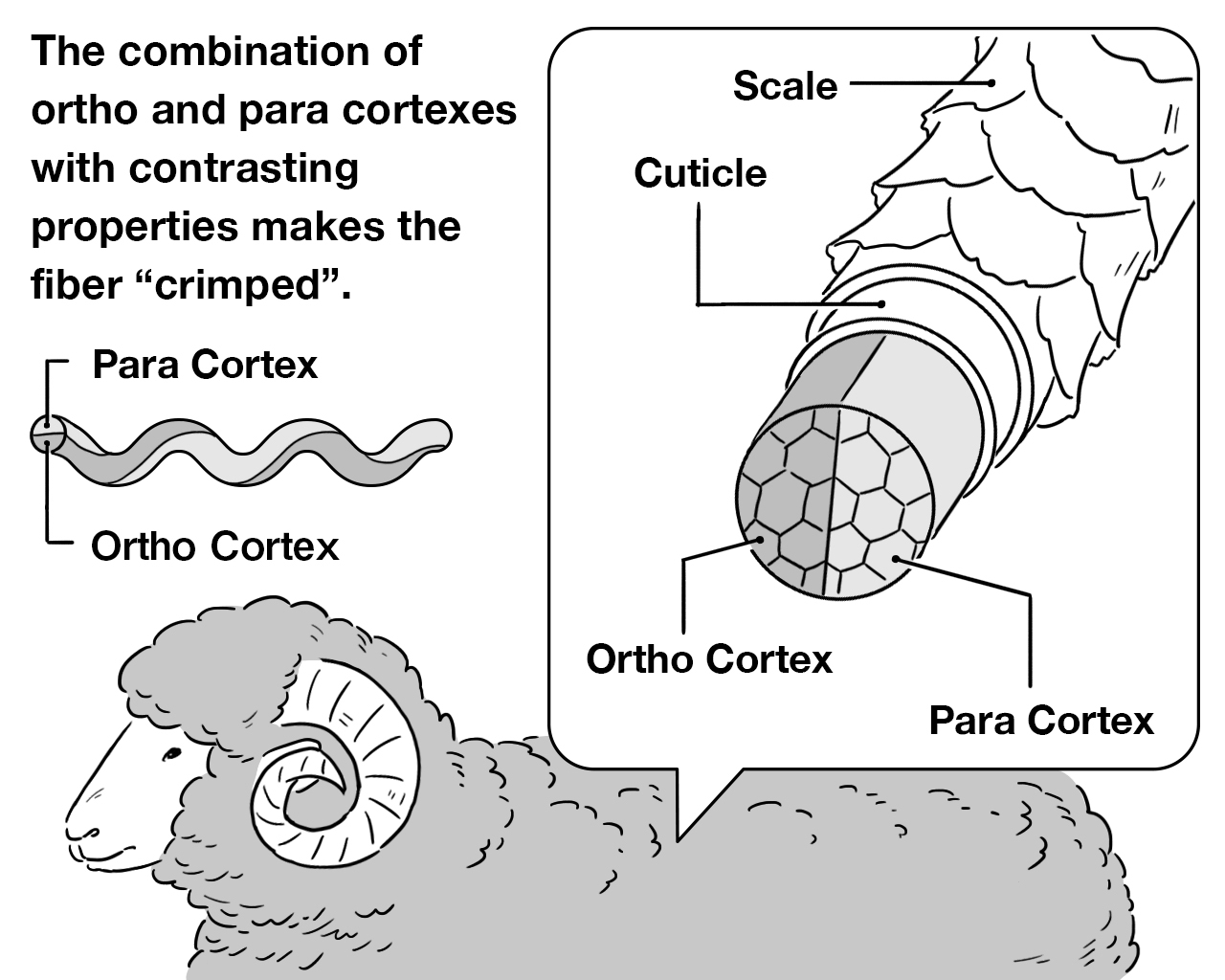
Disadvantages of Wool
Wool or merino wool has various features and functions, but it is not flawless.
- Heavy when wet
when it’s wet and takes longer to dry compared with most synthetic materials. Fast-drying synthetic materials, however, can be cold when wet because it deprives body heat excessively quickly as it dries due to evaporation. Wool dries slower than synthetic materials but quicker than cotton with a similar thickness.
- Liked by insects
Soft, natural fibers such as wool, cashmere, and silk are prone to damage by insects.
- Tears easily
The relatively short fibers of wool mean that wool fabrics are easier damaged than synthetic and cotton fibers. However, small holes can easily be fixed with a bit of pure wool and a needle.
- Shrinks easily
Wool generally shrinks easily, even when shrink-proofed. To reduce shrinkage, after the wash, please spread the shirt well to return to the original shape and gently iron it.
- Distortion
When knitted wool fabrics are washed, the material is likely to distort diagonally because the yarned fibers absorb water, swell, and tend to untwist. Consequently, the shape of the shirt may distort slightly with washing.
- Distinctive smell
The wool comes from sheep and you may experience a distinctive animal-like smell coming from your t-shirt when damp. This smell disappears after the fabric dries.
The above information was compiled and edited based on the interview with the textile company and the research institute, and the reference book below:
Bibliography: Structure and Physical Properties of Wool, Japan Wool Industry Association, Seni Co., Ltd.
Size guide
Recommended Size
| Size | XS | S | M | L | XL |
|---|---|---|---|---|---|
| Weight (kg) | 42~53 | 51~61 | 59~69 | 67~78 | 76~85 |
| Chest (cm) | 78~84 | 80~88 | 84~95 | 92~102 | 100~110 |
Product Size
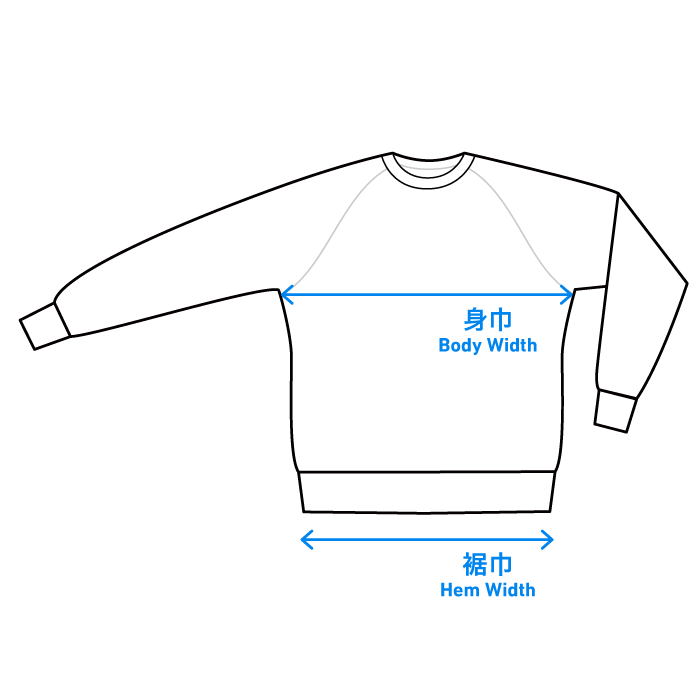
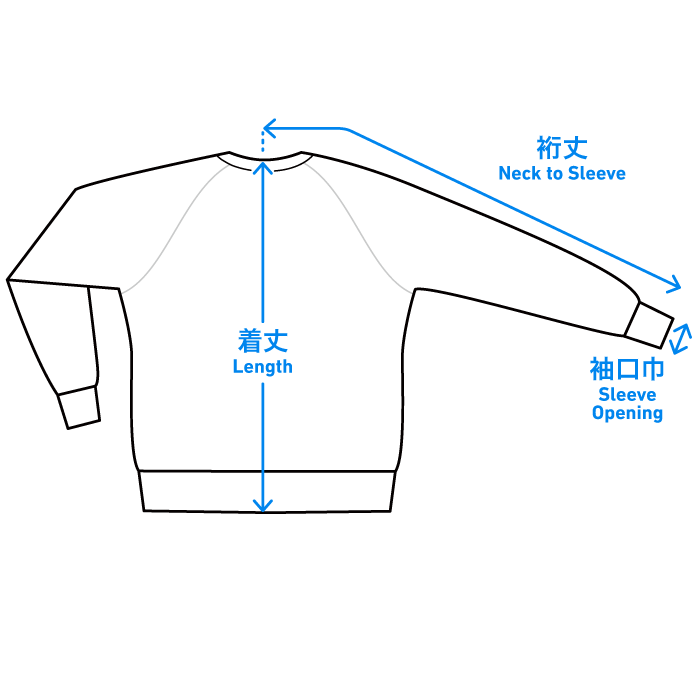
Unit:cm
| Size | XS | S | M | L | XL |
|---|---|---|---|---|---|
| Length | 65 | 68.5 | 71.5 | 73.5 | 75.5 |
| Body Width | 46.5 | 51.5 | 54 | 58 | 62 |
| Hem Width | 38.5 | 42.5 | 44.5 | 48 | 51.5 |
| Neck to Sleeve | 74.5 | 80.5 | 83 | 86 | 89 |
| Sleeve Opening | 7.5 | 8 | 8.5 | 9 | 9.5 |
The above sizes are the measurements when the product is brand new and unwashed. It will shrink about 1.5cm vertically and 1cm horizontally after a few washes.
Notes:
– Due to the elasticity of the fabric, there may be some individual differences in the size of the product.
– Due to the nature of the material, there may be some individual differences in the shrinkage. The extent of the shrinkage may vary depending on the type of washing machine or the machine settings.
– Using a dryer with a low-temperature setting may cause the garment to shrink more than when dried naturally. It will be restored after it is washed again and flat-dried.
– To reduce shrinkage after the wash, gently spread the shirt and iron it.

Our 100% Merino and 100% Merino Light products have wide-fit, standard-fit, and slim-fit: The 100% Merino Pullover is standard-fit.
Fitting
Instructions
Hydrophilic 100% Merino
While normal merino wool fabrics are water-repellent finished at the manufacturing stage, our 100% Merino has a hydrophilic finish for better wicking performance.
However, the yarn is waxed to improve knitting efficiency during the mass-production process, which may not be fully removed by washing in the final processing stage, and the remaining wax may repel water, hindering the fabric’s absorption.
For better wicking of the fabric, please wash two or three times to remove the residual wax.
Tumble-drying
This product is tumble-dried with a low-temperature setting (60 degrees Celcius or lower). Please note that the dryer should be used only when it is necessary to prolong the lifetime of the garment.
Care Instructions
- This product is made of highly odor-resistant merino wool, which usually does not require a frequent wash.
- The fabric uses shrink-proof pure merino wool. It is machine-washable by “Gentle Course” or “Hand Wash Course” with gentle water flow.
- When you store the item, use mothballs and/or vacuum storage bags to keep out insects.
- Merino’s fibers are short, and fuzz and pilling may appear, which can be removed by several washes.
Care Guide
Please visit ourCare Guideon the 100% Merino Series for more information.
Payment
- We only accept payment by credit card. We currently do not accept payment via bank transfer from overseas accounts.
- We accept the following Credit Cards: Visa, Master, American Express, and JCB.
- To download your receipt, please click the link included in the Dispatch Notice, which we will send by email as soon as the items are dispatched.
- Bank transfer is only availble for those that own a Japanese bank account.
Delivery
- Order Confirmation will be sent after the order.
- The items will be dispatched within 3 days after the payment is confirmed.
- The dispatch notice will be sent by email as soon as the items are dispatched.
- The delivery may be delayed by unforeseeable reasons such as natural disasters and other logistics issues. We appreciate your patience and understanding.
- We cannot ship multiple orders in one package due to how our delivery system is currently set up.
- We will ship to regions in North America, Oceania, and Europe (excluding Russia) via DHL. For regions in Asia, the Middle East, Central and South America, Africa, and Russia, we use EMS (International Express Mail Service) for shipping.
- Shipping fees and delivery times vary depending on the shipping destination as well as the size and weight of the items.
Size Exchange
- Overseas customers who need to change the size of their order, should note that the time needed for shipping will vary greatly depending on your country of residence.
- We only accept exchanges when the item is unused (except for fitting).
- If you wish to exchange the size of the item, please contact us within seven days of receiving your order.
- Exchanges can only be made for the same color in a different size.
- If the size you wish is out of stock, we will suggest a different color.
- If the product is out of stock, we may simply have to ship the item back to you.
- All shipping costs to be carried by the customer.
- We will only send the exchanged item to you, upon receipt of return shipping cost via PayPal.
- Please be aware that some countries charge customs duties depending on the price of the item.
- We are unable to answer any questions on local customs. Please contact your local customs bureau.
Repair
A natural fiber, merino wool has wonderful properties such as excellent temperature and humidity control and deodorant performances, but it also has a weakness; yarns are likely to break and develop holes due to abusive use and moth eating.
For inquiries on repairing holes or products damaged over time, please feel free to contact us from the “Repair” section of the SUPPORT page.
Needle Felting
Holes in merino wool cut-and-sewn products caused by thread breakage or moth bites can be repaired by felting, a technique to patch the hole with the raw wool using a special needle. You can repair by yourself, and Yamatomichi also offers felting repair services using raw wool of the same color as the product.
For more details of felting and how we repair the merino items, visit Yamatomichi JOURNALS “#1 Repairing Holes in Merino Wool“.







